Solving Common Causes of Welding Porosity
Estimated reading time: 7 minutes
Porosity, cavity-type discontinuities formed by gas entrapment during solidification, is a common but cumbersome defect in MIG welding and one with several causes. It can appear in semi-automatic or robotic applications and requires removal and rework in both cases — leading to downtime and increased costs.
The major cause of porosity in steel welding is nitrogen (N2), which gets involved in the welding pool. When the liquid pool cools down, the solubility of N2 is significantly reduced and N2 comes out of the molten steel, forming bubbles (pores). In galvanized/galvanneal welding, evaporated zinc can be stirred into the welding pool, and if there is not enough time to escape before the pool solidifies, it forms porosity. For aluminum welding, all porosity is caused by hydrogen (H2), by the same way as N2 works in steel.
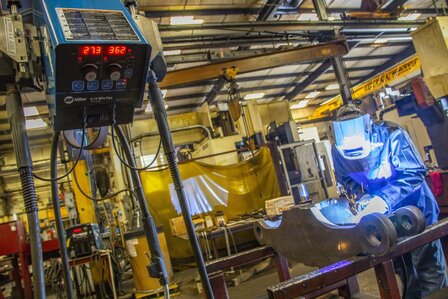
Welding porosity can appear externally or internally (often called sub-surface porosity). It can also develop at a single point on the weld or along the entire length, resulting in weak welds.
Knowing how to identify some key causes of porosity and how to quickly solve them can help improve quality, productivity and the bottom line.
Poor Shielding Gas Coverage
Poor shielding gas coverage is the most common cause of welding porosity, as it allows atmospheric gases (N2 and H2) to contaminate the weld pool. Lack of proper coverage can occur for several reasons, including but not limited to poor shielding gas flow rate, leaks in the gas channel, or too much air flow in the weld cell. Travel speeds that are too fast can also be a culprit.
If an operator suspects poor flow is causing the problem, try adjusting the gas flow meter to ensure the rate is adequate. When using a spray transfer mode, for example, a 35 to 50 cubic feet per hour (cfh) flow should suffice. Welding at higher amperages requires an increase in flow rate, but it’s important not to set the rate too high. This can result in turbulence in some gun designs that disrupts shielding gas coverage.
It’s important to note that differently designed guns have different gas flow characteristics (see two examples below). The “sweet spot” of the gas flow rate for the top design is a lot larger than that of the bottom design. This is something a welding engineer needs to consider when setting up the weld cell.


Also check for damage to the gas hose, fittings and connectors, as well as O-rings on the power pin of the MIG welding gun. Replace as necessary.
When using fans to cool operators or parts in a weld cell, take care that they are not pointed directly at the welding area where they could disrupt gas coverage. Place a screen in the weld cell to protect from external air flow.
Re-touch the program in robotic applications to make sure there is a proper tip-to-work distance, which is typically ½ to 3/4 inch, depending on the desired length of the arc.
Lastly, slow travel speeds if the porosity persists or consult a MIG gun supplier for different front-end components with better gas coverag
Base Metal Contamination
Base metal contamination is another reason porosity occurs — from oil and grease to mill scale and rust. Moisture can also encourage this discontinuity, especially in aluminum welding. These types of contaminants typically lead to external porosity that is visible to the operator. Galvanized steel is more prone to subsurface porosity.
To combat external porosity, be certain to thoroughly clean the base material prior to welding and consider using a metal-cored welding wire. This type of wire has higher levels of deoxidizers than solid wire, so it is more tolerant of any remaining contaminants on the base material. Always store these and any other wires in a dry, clean area of similar or slightly higher temperature than the plant. Doing this will help minimize condensation that could introduce moisture into the weld pool and cause porosity. Do not store wires in a cold warehouse or outdoors.
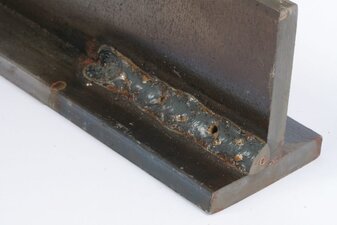
When welding galvanized steel, the zinc vaporizes at a lower temperature than the steel melts, and fast travel speeds tend to make the weld pool freeze quickly. This can trap zinc vapor in the steel, resulting in porosity. Combat this situation by monitoring travel speeds. Again, consider specially designed (flux formula) metal-cored wire that promotes zinc vapor escape from the welding pool.
Clogged and/or Undersized Nozzles
Clogged and/or undersized nozzles can also cause porosity. Welding spatter can build up in the nozzle and on the surface of the contact tip and diffuser leading to restricted shielding gas flow or causing it to become turbulent. Both situations leave the weld pool with inadequate protection.
Compounding this situation is a nozzle that is too small for the application and more prone to greater and faster spatter buildup. Smaller nozzles can provide better joint access, but also obstruct gas flow due to the smaller cross-sectional area allowed for gas flow. Always keep in mind the variable of the contact tip to nozzle stickout (or recess), as this can be another factor that affects shielding gas flow and porosity with your nozzle selection.
With that in mind, make sure the nozzle is large enough for the application. Typically, applications with high welding current using larger wire sizes require a nozzle with larger bore sizes.
In semi-automatic welding applications, periodically check for welding spatter in the nozzle and remove using welder’s pliers (welpers) or replace the nozzle if necessary. During this inspection, confirm that the contact tip is in good shape and that the gas diffuser has clear gas ports. Operators can also use anti-spatter compound, but they must take care not to dip the nozzle into the compound too far or for too long, since excessive amounts of the compound can contaminate the shielding gas and damage the nozzle insulation.
In a robotic welding operation, invest in a nozzle cleaning station or reamer to combat spatter buildup. This peripheral cleans the nozzle and diffuser during routine pauses in production so that it does not affect cycle time. Nozzle cleaning stations are intended to work in conjunction with an anti-spatter sprayer, which applies a thin coat of the compound to the front components. Too much or too little anti-spatter fluid can result in additional porosity. Adding in air blast to a nozzle cleaning process can also aid in clearing loose spatter from the consumables.
Maintaining quality and productivity
By taking care to monitor the welding process and knowing the causes of porosity, it’s relatively simple to implement solutions. Doing so can help ensure greater arc-on time, quality results and more good parts moving through production.
Employee Retention: Best Practices for Keeping Welders Engaged
Employee Retention: Best Practices for Keeping Welders Engaged
Estimated reading time: 4 minutes
The welding industry, like many others, is challenged by a labor shortage — and one that is growing. By 2023, the American Welding Society (AWS) anticipates the welder shortage to reach approximately 375,000, as an increasing number of experienced welders reach retirement age and leave the field.[1] With those statistics in mind, it’s more important than ever for companies to take steps to retain the welders they have.
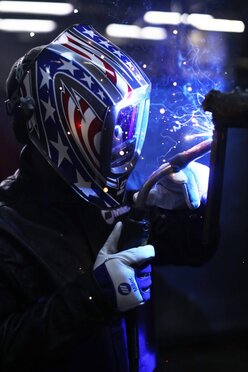
Employee retention is critical for several reasons. It helps support quality and productivity initiatives, which in turn makes it easier to meet customer demands. It also prevents overworking welders — an issue that can lead to low morale and a poor company culture. In addition, retaining welders helps maintain the bottom line. Turnover can cost companies significantly in terms of recruiting and retraining new welders, as well as for downtime in production due to lack of a full workforce. [2]
Fortunately, there are some best practices that can help companies create a positive environment and keep welders interested in the job.
Provide proper welder training
Empowering welders is important to instill a sense of interest and pride in the job —and that process should start from the very beginning. It’s reported that strong onboarding and training can help companies retain 82% of new hires. [3]
With proper training, welders can feel confident in their ability to do the job and help train new welders. Start with establishing good welding habits and creating a familiarity with the welding process. This includes training new welders on how to set up their power source accurately and safely and on what welding parameters to use. Equally important is providing guidance on the best technique for the process and application to minimize weld defects. Establishing a comfort level with following welding procedures is also a valuable part of welder training. [4]
For more experienced welders, offering more advanced training opportunities can help keep them engaged. This could include training to weld on more complicated applications or complex parts, robotic welding programming and more.
Create a clean, safe environment
Along with providing appropriate personal protective equipment (PPE), such as helmets, gloves, safety glasses and jackets, it is also important that the environment is safe. That means ensuring the welding cell and surrounding areas are free of clutter and any tripping hazards. It also entails proper ventilation. Companies can achieve that by removing weld fume at the source with a fume extraction gun, or with a mobile, wall-mounted system or a centralized fume extraction system. A clean, safe welding environment is more appealing for welders to work in — and it can provide an edge over competitive companies when it comes to employee retention. Additionally, be certain to train employees on all company safety protocols and welding equipment manufacturer’s safety precautions. Doing so can help create a culture of safety in which everyone is contributing. [5]
Offer easy-to-use welding equipment
Complicated equipment can be difficult to use, especially for inexperienced welders, leading to frustration about errors and downtime. This holds true not only for power sources, but also MIG guns and consumables: contact tips, nozzles, gas diffusers and liners. Liners, in particular, can be troublesome to install since it’s easy to trim them too long or too short, the latter of which happens more often. When the liner is too short, it can cause burnbacks, an erratic arc and poor wire feeding. Look for a consumable system that offers error-proof liner replacement for easier installation. This leaves welders more time to hone their welding skills while spending less time on troubleshooting. In automated welding operations, it is important to have equipment that is easy and intuitive to maintain and program after the proper training. This includes teach pendants with easy-to-use controls for inputting new parameters and requirements for the application.
Provide growth and advancement opportunities
Offering welders a chance to advance and learn new skills can be a good way to retain those who are interested in those opportunities. Growth can take many forms, whether it’s stepping into a new role or shouldering additional responsibilities within a current position. Certifications are another avenue for growth. The American Welding Society (AWS) offers its AWS Certified Welder performance-based program so welders can expand their knowledge and technique — from plate to pipe welding with a variety of processes. There are additional programs that support advancement, including one for a certified welding supervisor. [6]
Along with these best practices, keeping open lines of communication with welders is key — as it is in any work environment. Staying involved and creating a sense of community in which everyone is contributing to the well-being of the company can go a long way in keeping welders interested and engaged.
Pulsed Welding and Through-Arm Robots: What to Know
Pulsed Welding and Through-Arm Robots: What to Know
Estimated reading time: 6 minutes
After early adoption by the automotive industry, the combination of pulsed gas metal arc welding (GMAW) and through-arm robots has become a more common part of automated welding operations in general manufacturing and fabrication. In fact, through-arm robots have largely replaced conventional ones in the last decade as more robot OEMs lean toward that design.
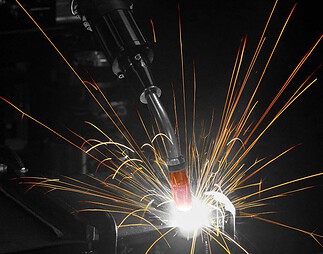
Pairing this type of robot with pulsed MIG welding can help companies improve productivity and quality. Through-arm robots, as their name implies, feature a hollow upper-arm casting that allows the welding power cable to run through the center. This design eliminates the need for the cumbersome cable management usually associated with conventional robots. Routing the cables through the arm also prevents them from getting caught on tooling or parts. The design improves joint access by reducing the overall size and shape of the robotic welding gun (i.e., end-of-arm tooling). Pulsed welding enhances the benefits of this combination by helping lessen part distortion, minimizing burn-through — especially in instances when the robot’s tool center point (TCP) is off — and reducing spatter.
The pulsed welding waveforms, however, can create wear on the through-arm robot’s welding gun components, such as welding consumables and welding power cables. Companies need to consider several factors during their selection and operation to gain consistent results and help these components last.
Understanding the impact of pulsed waveforms
Pulsed welding works well for lap joints on thinner materials, which is why it is prevalent in the automotive industry. Galvanized steel used for vehicle body skins, for example, may be as thin as 0.7 millimeters. Pulsed welding can also be used for thicker materials, up to and beyond 1/4 inch, with good results.
This welding transfer mode operates as a modified spray transfer process and requires a power source with specific pulsing capabilities. During operation, the welding output switches rapidly between high peak and low background currents. The peak current is responsible for pinching off the molten droplet from the filler metal and easing it toward the weld joint. While this is happening, the background current keeps the arc on and stable but is too low to transfer any filler metal. The weld pool cools slightly while the low background cycle occurs.
While pulsed welding offers benefits that support quality, the waveforms also cause a higher level of electrical and thermal stress on the through-arm robot’s welding power cable, since it is confined within the arm of the robot as opposed to being externally routed over the arm. The waveforms can also be harsh on welding consumables — particularly contact tips.
Impact on Contact Tips
The peak amperage values in a pulse waveform can cause micro-arcing inside the contact tip, which leads to higher resistance and ultimately burnback or the fusing of wire inside the bore of the contact tip. Chrome zirconium contact tips are slightly harder than copper tips and resist mechanical wear better in CV applications. However, a pulsed-welding-specific contact tip is needed to combat the electrical wear and micro-arcing and extend tip life in pulsed welding applications.
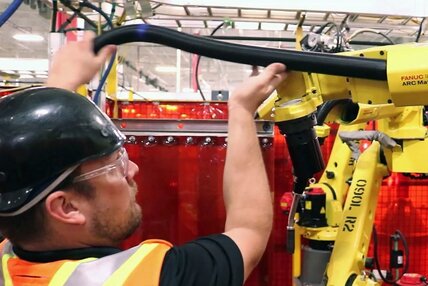
Impact on Welding Power Cables
Pulsed waveforms can be similarly hard on the welding power cable in a through-arm robot. Variations in welding joint access can put stress on the cable as the robot arm articulates, which can affect the current path. Again, the amperage peaks associated with pulsed waveforms can transfer across any open connections. If electrical resistance is high, the current will travel toward an easier path, leading to damage to the copper within the cable and burnt or shorter liners.
Unfortunately, it is difficult to predict cable failure in a pulsed welding application since there are few indicators. Periodically, the liner may become fused within the welding power cable or become discolored due to the current taking the liner as the path of least resistance as the power cable fails. If any cracks in the power cable jacket or exposed copper appear, it is time to replace the cable.
Ways to combat wear
There are steps companies can take to help minimize wear caused by pulsed waveforms to make through-arm robot components last longer.
1. Use Contact Tips for Pulsed Welding
As mentioned previously, companies can look for contact tips designed specifically for pulsed welding. These are made from materials that better resist electrical stress and also tend to have a tighter inside diameter (ID) in the bore to reduce the opportunity for the welding wire to float. This helps the contact tip conduct electricity much more efficiently and for longer while maintaining a tighter TCP. These contact tips can also help minimize burnback.
2. Check Contact Tip to Work Distance
Paying attention to contact-tip-to-work distance (CTWD) is also important. It needs to be consistent along the entire length of the weld joint. This supports correct parameters in the pulsed welding process and reduces spatter that could shorten the life of the contact tip.
3. Select the Best Welding Power Cable
Welding power cables with a dynamic or sliding electrical connection help ensure electricity can pass through uninhibited even when the cable experiences mechanical stress from the robot’s movements. This improves the ability of the pulsed waveform to transfer current more efficiently. Companies should also select a power cable with reliable, consistent electrical connections and consider replacing the cable annually in high-production environments.
4. Improve the Robot Arm Path
Improving the path of the robot arm, to ease extreme bending and twisting at joints five and six (J5/J6), is another way to minimize power cable wear. There are means to program the through-arm robot so that it can reach the weld joints efficiently without impacting cycle time. Often the movements that companies need to change the most are air moves and wait or clear positions. The key is to use the robot arm in the most neutral position to reduce stress on the welding power cable, which can be done by minimizing the articulation of J5/J6 during welding and/or air movements.
Gaining the best results
In the right application, pulsed welding with a through-arm robot can help companies improve weld quality and productivity. Working with a trusted robot integrator, distributor and/or welding gun manufacturer can help ensure that the proper consumables and welding power cables are in place, as well as assist in programming the robot to provide the most efficient movements.
Republished Welding Journal (August 2022) with permission from the American Welding Society (AWS). Click here to view the original article.
The Value of Welding Consumables Trials
The Value of Welding Consumables Trials
In both semi-automatic and automated welding cells, the upfront cost of welding consumables is low compared to the overall expense for equipment, materials and labor. Yet when companies accrue downtime for excessive welding contact tip changeover or troubleshooting poor wire feeding associated with liner issues, costs can quickly compound.
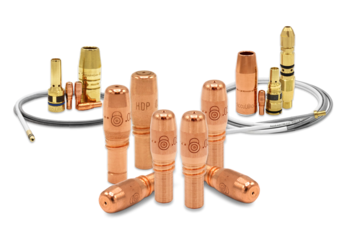
At times, companies may try to mitigate consumable problems without a true sense of the root cause, implementing a solution without data to back up the decision. However, conducting a welding consumables trial can provide insight into whether an operation is using the best consumables for the application.
Welding contact tips are the baseline for these trials since they are the most frequently changed consumable. Nozzles and diffusers that are compatible with the contact tip are included in a trial but not monitored in the same way since they last much longer.
This article has been published as an exclusive with The Fabricator. To read the entire article, please click here.
BERNARD DISCONTINUED PRODUCT — EFFECTIVE AUGUST 1, 2022
BERNARD DISCONTINUED PRODUCT — EFFECTIVE AUGUST 1, 2022
August 1, 2022
Bernard has discontinued the sales of the Q150 semi-automatic air cooled MIG guns as of August 1, 2022.
Click here for a list of discontinued part numbers.
Replacement MIG gun options would be a configured Bernard® BTB 200 amp or TGX 180 amp MIG gun.
If you have any questions regarding this change, contact your local ITW representative.
Understanding the Impact of Time Sinks in Robotic Welding
Understanding the Impact of Time Sinks in Robotic Welding
Estimated reading time: 7 minutes
No robotic welding cell operates at 100% capacity. Parts handling, fixturing, periodic rework and even employee breaks all affect a robot’s ability to be completely efficient. However, there are common time sinks that can further hinder productivity — and they can easily lead to increased costs and lower quality.
Time sinks are activities that consume a lot of time for little benefit. So why do these happen? It could be a lack of training or lack of skilled labor. Or it could be simply out of habit; some activities may fall into the “we’ve always done it this way” category.
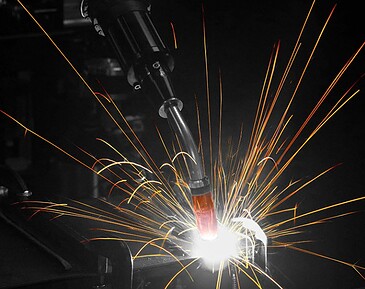
The key is to take steps to rectify these issues quickly, as they can easily escalate. That is especially true on large production lines. If one robot has an issue, it may result in having to stop an entire line of robots to solve the problem, compounding downtime.
Streamlining the process
Downtime for certain activities in a robotic weld cell is unavoidable, but they become time sinks when they aren’t streamlined. Welding contact tip changeover is a prime example.
While regular changeover is imperative to producing quality parts, it is not uncommon for operators to replace a contact tip before it is necessary. It can become a habit to change the tip every few hours, during breaks and before and after shifts without truly knowing whether there is still life left in the consumable. This frequency interrupts production, resulting in fewer parts being made and increased costs for the tip itself.
Conducting a time study to determine the true life of a contact tip — from installation to the point of failure — can help companies avoid excessive changeover and costs. The study may be time-consuming initially, but it can be conducted in one robotic welding cell to establish a baseline and then applied to similar cells.

It’s also recommended to try different types of contact tips to ensure that the best option is in place. For example, pulsed MIG welding applications are especially harsh on tips, so it’s essential to have an option for that waveform, like the AccuLock™ HDP contact tips, to extend product life. There is a higher upfront cost for these tips, but also a significant increase in productivity and throughput due to significantly less-frequent changeover.
Reaming too often can also become a time sink in a robotic welding cell. A nozzle cleaning station (or welding reamer) is necessary to clear spatter from the front-end welding consumables and ensure smooth gas flow, but it’s important to determine the optimal frequency for the application. For example, if a robot completes a 2-inch weld and then spends 10 seconds to ream, spray anti-spatter, nozzle-check and wire-cut, that is likely too often. Instead, it may be possible to weld 10 to 20 parts between reaming cycles. Again, a time study can help determine the appropriate frequency.
Common time sinks and tips for avoiding them
True time sinks may not be immediately obvious and the activities themselves may appear benign, but they can have consequences that result in extra time, labor and costs for welding troubleshooting. Fortunately, there are options to rectify these issues.
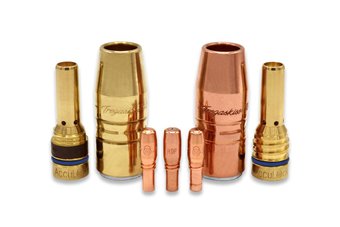
1. Poor wire conduit management
Due to the high volume of parts that pass through a robotic welding cell, most companies employ large welding wire drums to minimize changeover of these packages. Poor management of the conduit leading from the drum to the robot can lead to time sinks. If this conduit is too long, has been placed around the corner or snakes and bends along the floor, the wire won’t feed properly. Poor wire feeding can lead to burnbacks that require downtime for welding contact tip changeover. It can also cause the arc to become erratic, which causes quality issues and potential rework. The best way to resolve this issue is to keep the conduit as straight as possible and use the shortest run feasible.
2. Incorrect robot positioning and neck selection
Many large companies, such as tier-one automotive suppliers, measure their efficiency based on available square footage, so placing many robots in an area is common. This helps meet high production goals. However, if a company positions the robot incorrectly in relation to the tooling, it can increase robot articulation and lead to premature cable failure. The same holds true when using the wrong robotic MIG gun neck. While companies often like to standardize on one neck angle throughout the operation, it may not allow the robot to articulate properly to reach the weld joint.
As a best practice, the robot riser should be sized to minimize the amount of joint articulation when accessing the tooling. This reduces stress on the robotic MIG gun and the power cable. Select the appropriate neck angle to achieve the best joint access.
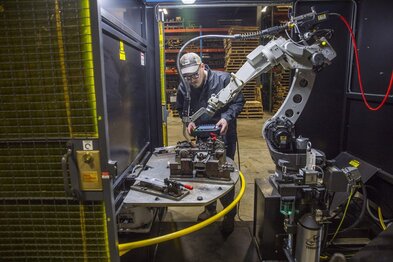
3. Troubleshooting on the line
When something goes wrong in a robotic welding operation, often the first instinct is to try to troubleshoot the issue on the spot. Doing so yields little benefit since it stops production: not just because the robot isn’t working, but also because multiple personnel may be stepping away from their jobs to address the problem. That adds up to unnecessary time and money spent.
A better option is to remove and replace the component causing the trouble, whether it be the robotic MIG gun or a welding reamer. That allows the robot to go back to work producing parts, while maintenance troubleshoots and repairs the equipment issue offline.
4. Overlooking preventive maintenance (PM)
Like troubleshooting on the line, reactive maintenance can be a significant time sink. Addressing unexpected problems keeps the robot from its job of producing parts. Also if something goes wrong within the weld cell because PM wasn’t performed, it can lead to poor quality parts, rework or costly repairs.
Instead, welding supervisors and operators should schedule time to perform preventive maintenance, such as checking connections and visually inspecting consumables for spatter during routine pauses in welding. More time-consuming PM activities, like replacing a gun liner, a robotic MIG gun or cable, or cleaning the robot, can happen between shifts or during other planned downtime.
Making a difference
When there are jobs to be done, it’s easy for companies to focus on moving production along and sending parts out the door. In the process, time sinks can occur that may be overlooked for long periods of time, compounding their severity.
However, pausing to look at the robotic welding operation and setting plans in place can help create efficiencies in the long run. In addition to time studies, conducting a process failure mode analysis (PFMA) can help by considering anything that could go wrong in the robotic welding cell. These situations are then ranked by potential frequency and severity and a plan put in place for addressing them.
It’s also important to remember that changes and improvements aren’t one-time occurrences. They must be monitored regularly and adjusted as needed. Coordinating a continuous improvement team to spearhead the process can help, as can working with a trusted welding equipment or robot manufacturer.
How to Reduce Welding Gun Wear and Extend Gun Life
How to Reduce Welding Gun Wear and Extend Gun Life
Estimated reading time: 5 minutes
Knowing the common causes of MIG gun wear — and how to eliminate them — is a good step toward minimizing downtime and costs for addressing issues.
Like any equipment in a welding operation, MIG guns are subject to routine wear and tear. The environment and the heat from the arc, along with other factors, impact their longevity. When operators follow best practices for their use, however, most quality MIG welding guns can last at least one year in a manufacturing environment. Routine preventive maintenance can also help extend product life.
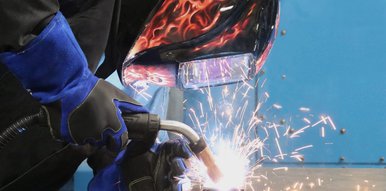
What causes MIG gun wear?
The welding environment and application can affect MIG gun life. Some of the most common causes of gun wear include:
Temperature changes
Extreme temperature fluctuations can affect the condition and expected life of the MIG gun jacket, which is typically a rubber-type composite material. If temperatures fluctuate from high to low, the jacket material will react differently — becoming softer or harder — which eventually leads to wear.
Environmental damage
Whether you’re welding inside a facility or on an outdoor jobsite, dirty conditions can introduce abrasives and debris into the MIG gun circuit and consumables. Guns can also be damaged if they are dropped, run over, walked on, or caught in a lift arm or boom. These actions can damage the cable or cause disruption of the shielding gas flow. Welding on or near abrasive surfaces can cause cuts to the gun jacket or cable. It’s not recommended to weld with a MIG gun that has a damaged jacket. Always replace worn, damaged or cracked guns or cables.
Lack of proper maintenance
When dirt and debris build up within the gun liner or on the contact tip, it increases resistance and causes additional heat buildup — the enemy of gun life. A wire feeder that isn’t feeding properly can also cause damage elsewhere in the gun.
A broken handle or noticeable chips or cuts in the gun jacket or cable are common indicators of MIG gun wear. But other signs aren’t always visible.
If a burnback, erratic arc or poor-quality welds are an issue during welding, these could be caused by inconsistent power being delivered to the weld circuit. Worn connections or components in the welding gun can cause these power fluctuations. To avoid downtime and additional wear on the gun, it is important to troubleshoot weld or arc issues and fix them as quickly as possible.
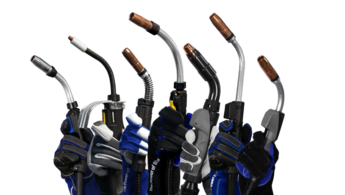
Tips for preventing MIG gun wear
Consider these five tips to help optimize gun performance and longevity.
- Don’t exceed the duty cycle. Manufacturers have the option of rating their guns at 100%, 60% or 35% duty cycle. Duty cycle is the amount of arc-on time within a 10-minute period. Exceeding the gun’s rating can result in excess heat that wears gun components more rapidly and can potentially damage them to the point of failure. If an operator feels the need to increase parameter settings to achieve the same weld they previously completed, this could be a sign that the gun has begun to fail or something is wrong with the weld circuit.
- Use a quality jacket cover. To protect the cable from gashes or sharp objects in the welding environment, use a gun jacket cover made from a material that offers a higher abrasion resistance. Jacket covers are available in various lengths to suit many gun styles and sizes. Be sure to replace the jacket as needed for maximum protection.
- Check consumable connections. Any loose connection in a weld circuit will increase heat and resistance, which in turn will increase wear on the gun and components. When changing consumables, be sure threads are clean and tight. Inspect the gun regularly, tightening any loose connection — whether it’s the diffuser, neck or contact tip. Loose connections inhibit power transfer within the circuit for the weld. It’s also important to check all connections after servicing the gun or changing consumables.
- Properly manage the cable. The best condition for any weld cable and gun is to keep them as straight as possible during use. This provides better wire feeding and power transfer down the length of the gun. Avoid kinking the cable or using a gun and cable that are too long for the space. When the gun isn’t in use, be sure to coil the cable properly. Keep the gun and cable off the floor or ground and out of harm’s way — ideally on a hook or shelf. Keep guns out of heavy traffic areas where they could be run over or damaged. Also, if the gun is on a boom, don’t pull the gun cable to move the boom or cart. This can damage the connections and wear them down faster.
- Conduct preventive maintenance General maintenance and upkeep will help MIG guns perform as expected and prolong gun life. Pay attention to any signs of wear on the gun or consumables. Check all connections each time the gun is used and look for spatter buildup in the nozzle. Troubleshoot any gun or wire feeding issues as soon as possible. Also, be sure to use the correct parts when servicing or repairing a MIG gun. MIG gun manufacturers typically have a parts guide that indicates which parts go into a specific position on the gun. If the wrong parts are used, they will change the way power transfers through the gun as well as affect overall performance. This can increase wear over time.
Optimizing MIG gun life
Getting the most life out of your MIG welding gun involves numerous factors, from proper maintenance and care to using best practices when welding. Keeping an eye on MIG gun wear and changing consumables as necessary can help prolong gun life and deliver better performance for longer.
8 Manufacturing Cost-Reduction Strategies for Welding Operations
8 Manufacturing Cost Reduction Strategies for Welding Operations
Cost overruns in a manufacturing welding operation can come from many places. Whether it’s a semi-automatic or robotic weld cell, some common culprits of unnecessary costs are unplanned downtime and lost labor, consumable waste, repairs and rework, and lack of operator training.
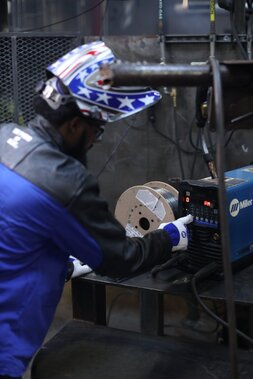
Many of these factors are tied together and influence each other. A lack of operator training, for example, can result in more weld defects that require rework and repair. Not only do repairs cost money in additional materials and consumables used, but they also require more labor to do the work and any additional weld testing.
Repairs can be especially costly in an automated welding environment, where constant progression of the part is crucial to overall throughput. If a part isn’t welded correctly, it may still continue through all steps of the process. If the defect isn’t caught until the end of the process, all the work must be redone.
Companies can use these eight tips to help optimize consumable, gun and equipment performance — and reduce costs in both semi-automatic and robotic welding operations.
This article was published as an exclusive on thefabricator.com. Read the full article here.
Cobots and Cobot MIG Guns: What To Know for Manufacturing Welding Operations
Cobots and Cobot MIG Guns: What To Know for Manufacturing Welding Operations
Traditional robotic welding systems can deliver many benefits, but they aren’t always the right solution for every manufacturer. In applications where implementing a robotic weld cell isn’t the answer, some companies are turning to collaborative robots, or cobots.
While not new to the industry, cobots are currently a fast-growing and still-developing technology. They can help operations save time, improve part quality and deliver consistency — all at a lower investment cost than a robotic welding system.
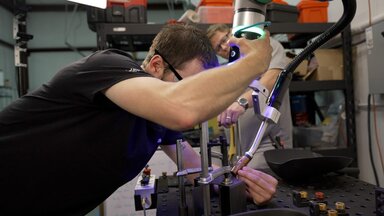
Knowing the basics goes beyond just the equipment itself. It’s also important to understand how cobot welding gun and consumables selection play key roles in optimizing this technology.
Why cobots?
Cobots are still industrial robots, but they are designed to operate safely alongside workers and enable human collaboration with the robot. As an example, a cobot may be welding a workpiece while the nearby operator inspects and cleans a weld that was just completed by the cobot — essentially turning one worker into two.
Manufacturers with high-mix, low-volume production (those that make smaller numbers of a wide variety of parts) are a good fit for cobots, making general manufacturing and job shops common adopters.
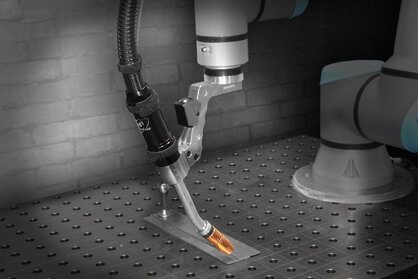
There are several benefits that can help operations save time and money while improving part quality. These include:
1) Lower total cost
Cobots are typically less expensive for operations to adopt compared to a fully automated welding cell. This includes the initial cost of the equipment and the training required to get operators up to speed for programming and using it. In addition, many companies that provide robot integration offer leasing options for cobots, making it easy for manufacturers to try out the solution before making a purchasing decision.
2) Ease of use and training
Cobots have intuitive touch-screen user interfaces and are significantly easier to use than traditional robotic welding cells. Operating a cobot requires some training, but little welding or programming experience is necessary to successfully operate it. Compare that to a traditional robotic welding cell, which typically requires more extensive welding or programming experience. The reduced level of training with cobots can be a plus for operations that struggle to find and retain skilled labor.
3) Reduced safety risks
Because cobots are designed to be operated with human interaction, they have many built-in safety measures. They are limited in how fast they can move, are very sensitive to collisions, and they do not have pinch points. They will stop movement in the event of a collision. And because of these design parameters, the cobots will not be moving very fast if they do collide with something. Cobots can be programmed to move faster when they are not working alongside a human.
4) Portability
Many cobots are portable — essentially a table with a robot on it. They can be moved elsewhere in the facility to be used where they are needed. This allows operations to easily change which production line is using it.
Implementing cobots
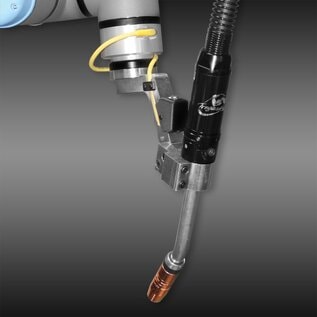
Cobots are designed to offer a low barrier to entry — with fast setup and high ease of use. The programming required and specifics of the user interface will vary based on the integrator, but often the cobot is controlled by a tablet or cell phone app — making training and programming very easy. Some cobots are assembled before they are shipped, so setup only takes 30 minutes to an hour.
Once set up, operators can move the cobot to exactly the spot they want to start the weld and push a button to save that point. Then they can move the cobot to the end point of the weld and save that point. This can be easily repeated for each weld.
Some cobots allow the addition of different features to the programming, such as seam welds or stitch welds.
Choosing a welding gun and consumables
While it’s easy for the selection of a welding gun and consumables to be an afterthought in the process, these play an important role in the performance and efficiency of any welding system, including a cobot.
Choose a high-quality gun and consumables to optimize results, provide longer product life and reduce the time and money spent on troubleshooting. Reducing consumable changeover and potential issues is especially important for companies with less-experienced operators.
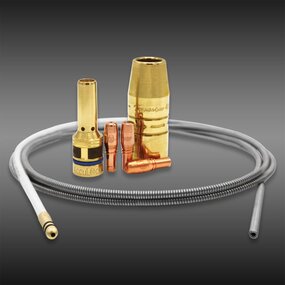
MIG guns for cobots are tested and rated using the same standards applied to traditional MIG guns. Be aware of what the rating means when selecting a MIG gun for cobot welding, as it helps prevent overheating when guns are used as they are rated.
A gun like the Tregaskiss BA1 cobot MIG gun features metal-to-metal connections that hold it in place in the mounting arm and keep the aluminum-armored neck firmly connected in the gun body to ensure accurate, quality welds. It also has minimal fasteners and a precision-machined keyway mounting system, making installation of the gun and mounting arm quick, easy and accurate.
To simplify maintenance, consider a front-load liner, since these can reduce downtime for changeover. The liners are replaced from the front of the gun without disturbing the gun, wire or feeder connection. Liner issues and challenges with liner replacement are a common cause of troubleshooting with both cobot MIG guns and traditional robotic ones. Having an easier liner replacement process helps reduce or avoid problems.
Look for consumables, like AccuLock™ R contact tips, nozzles and gas diffusers, that are designed to maximize production uptime through long service life and quick replacement. Since contact tip cross-threading issues can be a source of downtime in welding operations — especially with less experienced welding operators — these consumables feature coarse tip threads that help to eliminate the problem. They also feature increased mass and are buried within the diffuser, away from the weld, to increase tip life.
Cobots in welding
In the right manufacturing operation, cobots can help improve productivity and efficiency and lessen the strain on operations having difficulty finding skilled welders.
However, users expect a quick-to-implement and easy-to-use solution that keeps their operations agile and profitable. Choosing durable, high-quality cobot MIG guns and consumables for a cobot system can keep operators focused on manufacturing quality parts instead of troubleshooting or maintenance. This helps operations achieve their productivity and quality goals — and get the results they want.
Creating a Smooth Wire Feeding Path for MIG Welding
Creating a Smooth Wire Feeding Path for MIG Welding
In MIG welding applications, having a smooth wire feeding path is critical. The welding wire must be able to feed easily from the spool on the feeder through the power pin, liner and gun and up to the contact tip to establish the arc. This allows the welding operator to maintain consistent levels of productivity and achieve good weld quality, while also minimizing costly downtime for troubleshooting and potential rework.
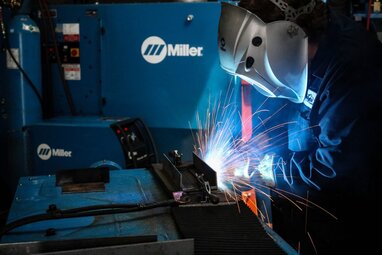
However, there are several issues that can disrupt wire feeding. These can cause a host of problems, including an erratic arc, burnbacks (the formation of a weld in or on the contact tip) and birdnesting (a tangle of wire in the drive rolls). For new welding operators who may not be as familiar with the MIG welding process, these problems can be especially frustrating. Fortunately, there are steps to easily prevent problems and create a reliable wire feeding path.
Welding liner length has a big impact on how well the wire will feed through the entire path. Too long of a liner can result in kinking and poor wire feeding, whereas a liner that is too short won’t provide enough support to the wire as it passes through. This can ultimately lead to micro-arcing within the contact tip that causes burnbacks or premature consumable failure. It can also be the cause of an erratic arc and birdnesting.
Trim the liner correctly and use the right system
Unfortunately, welding liner trimming issues are common, particularly among less experienced welding operators. To take the guesswork out of trimming a welding gun liner correctly — and achieve a flawless wire-feeding path — consider a system that eliminates the need for measuring the liner for replacement. This system locks the liner in place at the back of the gun, allowing the welding operator to trim it flush with the power pin. The other end of the liner locks at the front of the gun at the contact tip; it is concentrically aligned between the two points, so the liner won’t extend or contract during routine movements.
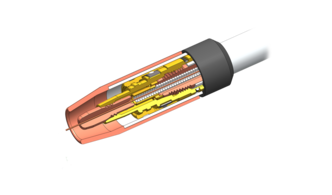
When using a conventional liner, avoid twisting the gun when trimming the liner and use a liner trim gauge when provided. Liners with an interior profile that imparts less friction on the welding wire as it goes through the liner are a good choice for achieving efficient wire feeding. These have a special coating on them and are coiled out of a larger profile material, which makes the liner stronger and offers smooth feeding.
Use the right contact tip and install correctly
Matching the welding contact tip size to the diameter of wire is another way to maintain a clear wire feeding path. For example, an 0.035-inch wire should be matched to the same diameter contact tip. In some cases, it may be desirable to decrease the contact tip by one size to gain better wire feeding and arc control. Ask a trusted welding consumables manufacturer or welding distributor for recommendations.
Look for wear in the form of keyholing (when the contact tip bore becomes worn and oblong) since this can cause a burnback that prevents the wire from feeding.
Be sure to install the contact tip correctly, tightening it past finger tight to avoid tip overheating, which can hinder wire feeding. Consult the operations manual from the welding contact tip manufacturer for the recommended torque specification.
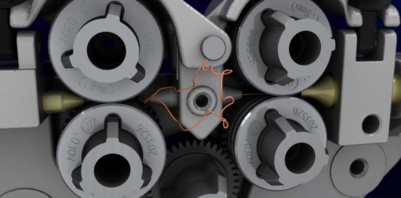
Choose the right drive rolls and set tension properly
Drive rolls play a significant role in ensuring a MIG welding gun has a smooth wire feeding path.
The size of the drive roll should match the size of the wire being used and the style depends on the wire type. When welding with solid wire, a V-groove drive roll supports good feeding. Flux-cored wires — both gas- and self-shielded — and metal-cored wires work well with V-knurled drive rolls. For aluminum welding, use U-groove drive rolls; aluminum wires are very soft, so this style won’t crush or mar them.
To set the drive roll tension, turn the wire feeder knob to one half turn past slippage. Pull the trigger on the MIG gun, feeding the wire into a gloved hand and slowly curling it. The wire should be able to feed without slipping.
Understand the impact of welding wire on feedability
The quality of welding wire and the type of packaging it is in both affect wire feeding. High-quality wire tends to have a more consistent diameter than low-quality ones, making it easier to feed through the entire system. It also has a consistent cast (the diameter when a length of wire is cut off the spool and placed on a flat surface) and helix (the distance the wire rises from the flat surface), which add to the wire’s feedability. While higher-quality wire may cost more upfront, it can help reduce long-term costs by minimizing the risk of feeding issues.
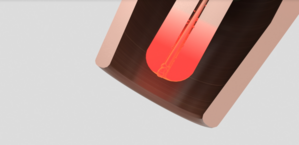
Wire from large drums typically have a large cast when dispensed from the packaging, so they tend to feed straighter than wires from a spool. If the welding operation’s volume can support a larger drum, this may be a consideration for both wire feeding purposes and for reducing downtime for changeover.
Making the investment
In addition to following best practices to establish a clear wire feeding path — and knowing how to quickly troubleshoot problems — having reliable equipment is important. The upfront investment for a high-quality wire feeder and durable welding consumables can pay off in the long term by reducing issues and the costs associated with wire feeding problems. Less downtime means more focus on producing parts and getting them out to customers.
5 Tips for Robotic Welding Process and Project Planning
5 Tips for Robotic Welding Process and Project Planning
Robotic welding projects can arise in a number of ways — from a smaller shop expanding its capabilities to a large original equipment manufacturer (OEM) awarding new business or even a new company establishing itself within the competitive landscape.
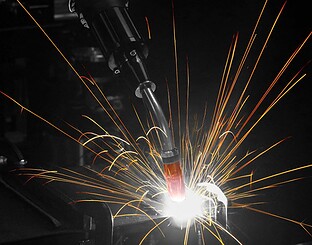
Regardless of the circumstances, it’s critical to implement a well-thought-out and thoroughly researched plan to ensure a successful robotic welding operation. The plan should cover both the details related to the welding process and the specific project at hand. This helps companies meet quality and productivity goals while maintaining their cost margins and achieving profitability.
Being proactive is the key with planning. Doing so helps minimize the opportunity for unforeseen risks that could be detrimental to the welding operation. Some basic tips can help along the way.
Tip No. 1: Ask questions
To determine the desired outcome for a robotic welding operation, it’s important to define the welding process — in terms of how efficient and quick it needs to be — and to consider all details related to the project’s budget. Asking some fundamental questions can help stakeholders define the scope of the process they are using and the project they are undertaking.
- What efficiencies do we need from the welding process?
- How labor-intensive will the process be?
- Is there adequate staff for loading/unloading fixtures?
- What training will staff need to keep the robot welding effectively?
- How many robots do we need? And how hard or long do we want the robots to work?
- What should we consider about the weld cell ergonomics?
- How should the robots be configured?
- What capital is available and how fast do we want our return on investment (ROI) to be?
Answering these questions can help companies as they plan out their project and conduct cost analysis.
Tip No. 2: Set realistic goals
Along with asking questions to set the foundation for solid process and project planning, it’s also important to set realistic goals. These goals should relate to general processes in the robotic weld cell along with desired quality outcomes.
For example, when considering the capabilities of the welding process in a robotic cell, a 75% to 80% efficiency rate may be a realistic goal. No welding process is 100% efficient, so it’s important to account for equipment downtime (planned or unplanned), consumable changeover, welding wire drum changeover and more.
The same holds true for quality goals. Having 100% quality isn’t necessarily true to life since weld defects like porosity can occur, tool center point (TCP) can shift and stampings can become misaligned. Each of these instances is possible (and probable) in an everyday robotic welding operation.
Setting realistic goals allows time for unexpected occurrences once the robotic welding system is at work.
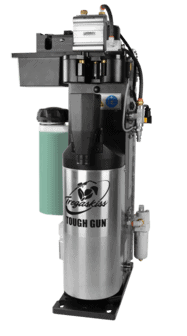
Tip No. 3: Look at the long term
While it may be tempting for companies to look for ways to reduce upfront costs during process and project planning, this doesn’t ensure that the long-term results are always positive. For example, neglecting to consider (and purchase) supplemental equipment, such as reamers (also called nozzle cleaning stations), can lead to greater expenses over the lifetime of a project.
Reamers clean spatter from the welding gun nozzle and gas diffuser to ensure smooth shielding gas flow that in turn supports good weld quality. Reamers are available in analog or ethernet models.
It’s important to consider reamer quality, especially for heavy-duty, higher-volume applications. While reamers with heavy-duty construction generally cost more, they also last much longer than light-duty models. Be sure to size the reamer appropriately for the project because reamers vary in the amount of torque they provide when removing spatter. Heavy-duty reamers provide more torque and have cutter blades that can reach deeper into the nozzle for a more thorough spatter cleaning.
Companies should also determine how much human interaction with the reamer is necessary to keep the welding process at target efficiency levels. For example, implementing a multi-feed anti-spatter sprayer system reduces time and labor for refilling the small sprayer reservoir on the reamer. It can feed multiple reamers from a large drum of anti-spatter solution outside the weld cell.
Tip No. 4: Pay attention to the small details
When it comes to identifying equipment for a robotic welding cell, it may be easy to overlook the importance of robotic MIG guns and consumables. While small in investment compared to a robot, each can have a significant impact on the efficiency of a welding process and the quality of the project.
Frequent changeover due to poor-quality MIG welding consumables or ones that aren’t appropriate for the application can add up. Be sure to select those that will be compatible with the heat inputs. Brass nozzles are strong and better able to resist spatter adhesion than copper nozzles. However, brass can be brittle at high temperatures, so they are best for lower-heat applications. Copper nozzles are better for high-heat applications but tend to allow greater spatter adhesion. For pulsed applications, where waveforms can be especially harsh on contact tips, an HDP tip can last longer, reducing the frequency of downtime caused by tip changes. The same holds true for contact tips that offer coarse threads to reduce the risk of cross-threading during replacement. When possible, standardize consumables throughout the entire welding operation to bring greater efficiencies.
Like consumables, the robotic MIG gun selected needs to match the duty cycle of the application to withstand the resistive heat and avoid overheating. The gun should also have an appropriate size of neck for the application to enable access to tooling and the weld joint.
Tip 5: Look for opportunities to optimize
Finding ways to maximize robot uptime is an important part of process and project planning. Robots are expensive, so companies want to be sure that they will get as close to 100% optimization as possible.
Having a high-quality welding wire, like a metal-cored wire, that supports faster travel speeds is one option to help optimize the robotic welding system. Look for wires with a consistent cast and helix to support smooth wire feeding.
Preventive maintenance (PM) programs help ensure that a robotic welding system operates efficiently, avoids unplanned downtime and supports more arc-on time. With a preventive maintenance schedule, companies can proactively check and change welding gun liners and MIG welding consumables during planned downtime, while also assessing the power cable and robot for damage.
It’s also important to plan for the ways that employees can support robot optimization. Training is critical. Properly trained robotic welding supervisors or technicians can be more effective at understanding the process and adjusting equipment as needed. Appropriate training can also help them run the equipment longer and more efficiently.
Putting everything to work
Once a company considers the key tips for process and project planning, they should be sure that everything works. Trials can help flush out unforeseen problems before starting full production and save money by preventing budget overages to fix issues.
After a project has been put into motion, take time for reflection. Revisit all aspects to see what worked and what didn’t. Continuing to learn from projects can help companies achieve future success.
Ways Welding Reamers Support Quality, Productivity and Safety
Ways Welding Reamers Support Quality, Productivity and Safety
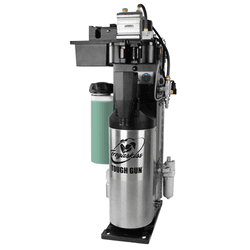
A successful robotic welding operation depends on the ability to maintain high levels of quality and productivity, while also keeping costs low. Unplanned downtime associated with consumable or equipment problems jeopardizes these goals. It can also increase the labor needed for troubleshooting and resolving issues.
But above all else, the weld cell needs to be a safe place for welding operators to work and interact with one another and the robotic welding system.
Peripherals, such as welding reamers (also called nozzle cleaning stations), can help companies achieve their goals, while also helping maintain safety.
This article was published in the August issue of The Fabricator. Read the full article here.
AccuLock Consumables Save Time and Money in MIG Consumable Changeover
AccuLock™ Consumables Save Time and Money in MIG Consumable Changeover
Estimated reading time: 5 minutes
They may seem like small pieces of a welding operation but when consumables aren’t properly installed or maintained, big problems can result — from poor wire feeding to weld quality issues. Related troubleshooting and rework cause costly downtime and lost productivity.
Consumable changeover can also be a time-consuming part of the welding process, especially if it’s necessary to do it frequently or if less experienced welders install consumables incorrectly.
Choosing the right consumables can help reduce or eliminate these hassles. Learn how AccuLock consumables can be used for Bernard® BTB MIG guns and Tregaskiss® fixed automatic and robotic MIG guns to help operations save time and money and improve efficiency.
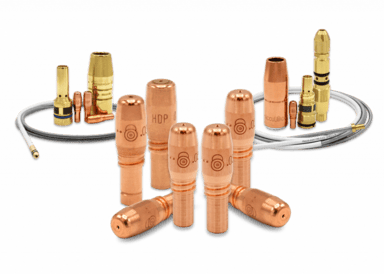
Although small in size, both AccuLock R and AccuLock S consumables can deliver sizable time- and cost-saving benefits by reducing troubleshooting and downtime in industrial welding applications.
The benefits of AccuLock consumables
AccuLock consumables are designed to address common challenges faced in both semi-automatic and automated MIG welding operations. A switch to AccuLock consumables can help operations:
- Increase consumable life while reducing costs and improving productivity.
- Reduce consumable replacement errors and the time and money spent on troubleshooting, rework and downtime.
- Simplify consumables replacement, improving accuracy and reducing employee training.
The AccuLock consumable family for industrial welding applications includes AccuLock R and AccuLock S systems, two options that are designed to deliver timesaving benefits and optimized performance in automated and semi-automatic welding applications.
Load and lock for increased productivity and throughput
The AccuLock S (Semi-automatic) consumables system features liners designed to resolve issues and errors with liner trimming and installation as well as erratic wire feeding problems. Because AccuLock S liners are locked and concentrically aligned to both the contact tip and the power pin, they offer a flawless wire-feed path and error-proof liner replacement every time. In addition, a steel retaining ring on the diffuser helps keep the threaded nozzle in place during use and cleaning.
The AccuLock R (Robotic) consumables system offers front-loading QUICK LOAD® liners that require less than half the time and effort to replace compared to conventional liners and can be changed from a safe zone in a robotic weld cell. Upgrading to AccuLock HDP contact tips can extend life by 10 times or more in pulsed welding applications. In addition, operations currently using TOUGH LOCK® consumables in robotic and fixed automatic MIG guns can easily upgrade to AccuLock R consumables without affecting TCP or requiring programming changes.
Choose according to your needs
When deciding between the two types of AccuLock consumables for industrial welding applications, there are several key factors to consider. It’s important to think about the type of welding being done in the operation and what current issues or challenges need addressing.
AccuLock S consumables are best suited for operations with the following issues or characteristics:
- Primarily focused on semi-automatic welding with little to no automation.
- Dealing with decreased productivity due to liner installation errors, burnbacks, bird-nesting and erratic arc.
- Wanting to reduce the time and costs of troubleshooting, downtime and rework.
AccuLock R consumables are best suited for operations with the following issues or characteristics:
- Primarily focused on robotic or fixed automatic welding with few semi-automatic guns.
- Having a complicated and costly consumables inventory that may be the root cause of frequent consumable replacement errors.
- Experiencing issues with contact tip cross-threading and want increased tip life.
Choosing between AccuLock S and AccuLock R on semi-automatic MIG guns
Customers who are currently using TOUGH LOCK consumables on Bernard BTB MIG guns can upgrade their guns with either AccuLock S or AccuLock R consumables. Although AccuLock S consumables offer many benefits specific to semi-automatic welding applications, in some cases it can make more sense for these welding guns to be upgraded to AccuLock R consumables instead. For example, if a complex inventory of MIG gun consumables is the primary root cause of high carrying costs and consumable replacement errors in a given facility, AccuLock R consumables may offer a better ROI.
Switching existing Bernard BTB MIG guns to AccuLock R consumables is an easy change to make, requiring only an AccuLock R diffuser and an AccuLock contact tip — with no need to switch the liner, power pin, power pin cap or nozzle.
Successful welding operations simplify inventory
Both AccuLock S and AccuLock R systems share a common contact tip to simplify inventory management for facilities that choose to use both. AccuLock contact tips last longer due to increased mass and being buried within the diffuser, away from the heat of the weld. Coarse threads work in tandem with a long contact tip tail to concentrically align the tip within the diffuser prior to thread engagement, ensuring quick, accurate replacement without cross-threading.
Getting the most out of MIG gun consumables
AccuLock S consumables solve many of the issues that can be traced to MIG gun liners that have been trimmed to an incorrect length or that pull out of position inside the MIG gun, creating gaps along the wire feed path. They are a good fit in most semi-automatic applications.
In fleets with a lot of automated welding, AccuLock R consumables can extend contact tip lifespan (especially in pulsed welding applications), eliminate contact tip cross-threading issues, alleviate excessive downtime for consumables replacement and limit safety issues related to climbing up to access robots or wire feeders for gun liner changes.
Although small in size, both AccuLock R and AccuLock S consumables can deliver sizable time- and cost-saving benefits by reducing troubleshooting and downtime in industrial welding applications.
Improve Productivity by Preventing 5 Common MIG Welding Problems
Improve Productivity by Preventing 5 Common MIG Welding Problems
Downtime and rework can be costly for manufacturing operations. The last thing any production team wants to do is the same work twice. If you add to that any time spent troubleshooting issues in the weld cell — the lost production time can start to accumulate quickly.
There are several steps operations can take to reduce the time lost to these common issues in MIG welding — and many of them start during weld setup and selection of consumables. Read on to learn more about five common causes of lost productivity in the weld cell and how to prevent them.
Cause 1: Poor fit-up or weld prep
Before welding even starts, pay attention to proper fit-up and joint design, as well as base material preparation and cleaning. Good fit-up means avoiding large or inconsistent gaps between the parts. Choosing the right wire size and gas mixture and matching those in advance can help optimize performance and provide proper gap filling capabilities.
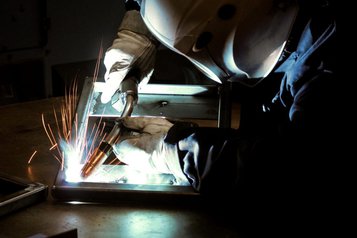
Certain welding wires, such as metal-cored wires, are usable on less-prepped base material by offering the ability to weld through mill scale or other surface impurities. They also offer good gap bridging. If operations are often getting parts that aren’t thoroughly cleaned, it may be worth testing a metal-cored wire. Otherwise, changes to the weld prep stage of the operation may be necessary to achieve better material condition prior to welding.
Cause 2: Incorrect parameters or system setup
Using the wrong parameters or setting the wire feeder up incorrectly are common causes of lost productivity. Having the wrong settings can greatly affect the weld, sometimes without the operator even realizing the impact that a setting change can make. It’s important to have a thorough understanding of the wire feeder and all of its functions to set it up for optimal performance.
When properly set up, there should be very few issues with the performance of the MIG welding gun. However, if the system is set up incorrectly or there is a poor weld circuit, it can lead to contact tip failure, since the contact tip is the smallest fuse in the weld circuit. This can result in money wasted on frequent contact tip changeover.
Cause 3: Improper liner installation
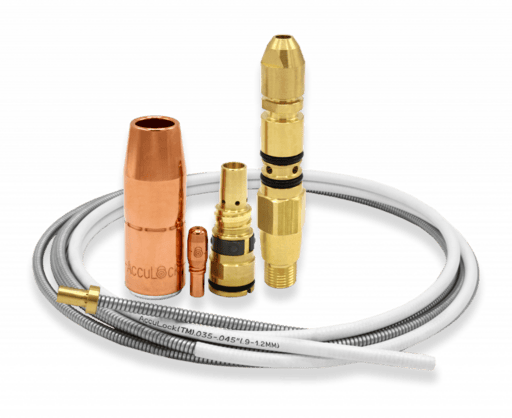
MIG gun liners can wear out over time and must be changed periodically, like other consumables. However, replacement liners are often longer than necessary and must be precisely trimmed according to the style and length of the gun. If a liner is cut too short, it can result in issues like burnback, an erratic arc and wire chatter. When liners are cut too long, it can cause the wire to weave and curve as it feeds through the gun.
With either too-long or too-short liners, the result is often poor wire feeding and downtime spent troubleshooting these problems. Maintenance and troubleshooting for liner issues can be costly, resulting in multiple hours per week lost for an operation.
The more that liner movement within the gun can be minimized, the better your wire feedability will be. To avoid the guesswork and hassle, look for a solution that makes liner installation and trimming easier. The Bernard® AccuLock™ S consumable system affixes the liner at both ends of the gun, so welders are assured the liner won’t pull back or push into the contact tip, allowing for smooth, uninterrupted delivery of the wire to the weld pool.
It’s also important to occasionally check to make sure the liner is clear and not blocked by debris or buildup.
Cause 4: Loose connections or neglected maintenance
When MIG welding consumables aren’t properly installed and maintained, it can result in wire feeding issues and weld quality problems that lead to lost time for troubleshooting.
For example, a loose connection in the weld circuit means you’re not getting the power you expect from the power source. In that case, the operator may keep adjusting the parameters, causing an increase in resistance that leads to shortened consumable life. These issues tend to show up first in the contact tip. This is often the first thing the operator changes if they think they have a problem with their MIG gun. Changing the contact tip — even when the real source of the problem is a loose connection or improper setup in the circuit — drives up consumable costs and wastes time.
Be sure to periodically check and tighten all connections and cables. Tight connections help optimize performance and reduce the chance of issues occurring in the system.
Cause 5: Cutting corners with contact tips
Another cause of lost productivity is using low-quality contact tips. Some contact tips are designed for ease of use and high performance. They provide better arc starts, less spatter, more consistent welds and longer life.
With Bernard AccuLock S consumables, 60% of the contact tip is buried in the gas diffuser to protect it from heat damage. As the shielding gas flows through the gun, it cools the contact tip tail inside the gas diffuser. This helps reduce heat and wear. This also differs from traditional tips that screw onto the gas diffuser with little to no portion of the tip exposed directly to the shielding gas as it exits the diffuser to the arc. The tapered design of the consumables tightly locks the conductive parts together to minimize electrical resistance and further reduce heat buildup. The contact tips also feature coarse threads, making them less likely to become cross-threaded.
Troubleshooting common welding problems
Common problems in the weld cell — from poor fit-up or wire feeding issues to using the wrong consumables for the job — can cost the operation significant time and money. Addressing the causes of lost productivity often starts with proper weld prep and setup, as well as making sure the chosen consumables are right for the application. Optimizing setup and efficiency in the weld circuit makes troubleshooting that much faster when issues do arise.
Implementing a Robotic Welding System: 5 Common Questions Answered
Implementing a Robotic Welding System: 5 Common Questions Answered
Estimated reading time: 7 minutes
Many manufacturing operations want to improve productivity and weld quality. Robotic welding can often help achieve these goals. But success with a welding robot doesn’t happen by chance. It takes a lot of upfront planning to help minimize the time and money you need later to make improvements or fix issues.
Before getting started, consider how these common questions could impact the way you establish a repeatable and consistent robotic welding operation — and how you can get the most out of it.
A: The filler metal used in a robotic welding system plays a critical role, as it can affect productivity, weld quality and overall costs. When you choose a wire for robotic welding applications, consider two things: the type and the thickness of the material being welded.
Across various industries, solid wire has been the standard for robotic welding. However, metal-cored wire may offer better productivity and higher quality benefits, especially for manufacturers of heavy equipment, automotive exhaust, chassis and wheels. Metal-cored wire not only allows for faster travel speeds and higher deposition rates, but it also more effectively controls spatter levels to reduce post-weld cleanup. Last, it offers improved welding through mill scale, which helps eliminate pre-weld grinding.
When in doubt, you can get suggestions from experienced welding equipment and filler metal manufacturers to help you match a welding wire to your process needs.
A: Performance in a robotic weld cell is significantly affected by your choice of robotic welding gun and consumables, including the nozzle, contact tip and liner. The right combination of gun and consumables can reduce unplanned downtime, increase lifespan and improve overall equipment effectiveness (OEE) in your weld cell.
There are three types of robotic guns to choose from, depending on your duty cycle and amperage ratings: air-cooled, water-cooled and hybrid. It’s possible for air-cooled guns to reach ratings of 350 to 385 amps at 100% duty cycle with mixed gases. Guns with this rating are well-suited for a variety of applications and help eliminate the need for water-cooled guns, which can be more complex and expensive to maintain. However, hybrid air/water-cooled designs incorporate water cooling on the front of the neck with an air-cooled cable. This design is good for applications with borderline air-cooled duty cycles that experience a higher frequency of consumable changeover. The hybrid gun is the best option to provide an additional rating boost while effectively cooling the consumables, leading to longer lifespans.
Robotic welding systems typically operate at higher duty cycles (compared to semi-automatic welding) and may use transfer modes that can be harsh on consumables. Consider using heavy-duty copper or chrome zirconium contact tips or high-quality tips designed specifically for pulsed welding. Chrome zirconium contact tips resist physical wear (or the keyholing effect) better than copper tips and are ideal for applications with long welds. Make sure to undersize the contact tip from the wire size when using 500-pound-plus wire drums to help ensure consistent wire contact with the tip due to the wire cast. Keep the tips on par with the wire size in small wire packaging.
Nozzle material also plays a factor in the application. Brass nozzles are stronger and have a lower spatter adhesion compared with copper, but brass is more brittle at higher temperatures. In short, brass handles spatter best while copper best handles higher heat.
Choosing a quality liner pays dividends in reducing your unplanned downtime. The majority of time, burnback in contact tips is a direct result of poor wire feeding or a liner cut too short. An accurately trimmed, quality liner will help to consistently improve wire feeding by reducing drag. The result is longer-lasting contact tips and improved robot uptime.
![]()
A: Several factors, such as material type, wire size and material thickness, influence the proper weld settings for an application. Some welding power sources have the ability to suggest recommended parameters based on the operator’s input for the application.
When a machine doesn’t have this technology, finding the correct parameters can involve some trial and error on your part to dial in heat and penetration. Consult with the robot manufacturer, welding power source manufacturer or system integrator. These partners can offer expertise and assist in choosing and testing specific materials to establish the proper weld parameters.
A: Establishing an accurate tool center point provides consistency and repeatability across parts and is vital for your system to maintain quality welds.
You can set your own standards for the acceptable amount of TCP drift based on the application and type of welds being made. To set the tolerance of TCP variation, an acceptable starting point can be half of the thickness of the wire diameter. Also keep in mind that your TCP correlates with your contact tip wear — the more key-holed a tip, the more off location your TCP will be.
Touch-sensing features that monitor TCP and track any shifts from the original setting are available on many robotic systems today. If a gun is out of acceptable TCP range, you can remove the neck and recalibrate it to the original specifications with a neck-straightening fixture. TCP can also be automatically adjusted internally by the robot on some systems.
It’s a good idea to schedule regular TCP checks. For example, it can be done every weld cycle, at the end of every shift or when the gun goes through a reamer cycle. The frequency of TCP checks is a matter of your priority preference. While it can be time-consuming to check after every shift, in the long run it can save money by avoiding rework if problems are caught early.
![]()
A: Much like programming the weld settings, programming the robot path may also involve some trial and error. When you initially program the robot’s path, think about four factors: the application, the material type, the welding process you are using and the gap size being filled. The travel angle — and whether it’s a push or pull weld — will impact the weld quality and aesthetic. Dialing in the correct path to achieve your desired results can take time.
Having the robot move to perch points or ready-to-enter points once the home positions are set helps to keep the robot safely away from potential collision areas. It also allows the system to move with air-cut moves to and from these points quickly and effectively.
When you program the robot to move to a weld, it’s common to set the approach point just above the weld start location. The robot should approach the start location at a slower and safer speed before it strikes an arc. This approach position provides a good lead-in and typically does not require adjustment unless the weld is relocated. Some robotic systems have technology that assists in setting the initial robot path.
The robot’s welding location can play a role in premature gun failures. Heavy articulation in the gun or an excess of +/-90 degrees, especially during welding, can cause accelerated cable failures. Minimizing your robot’s axis five and six during welding can help extend gun life by reducing wear.
Tips for robotic weld cells
Many variables, including proper cable and consumables selection and TCP control, play an important role in weld quality and gaining successful results with a robotic welding system. Establishing a thorough plan before implementation and continuing to monitor key issues can help you optimize your OEE so you can get the most out of your investment.
Manufacturer Cuts $45,000 of Costs With New MIG Welding Guns and Consumables
Manufacturer Cuts $45,000 of Costs With New MIG Welding Guns and Consumables
General Kinematics — a premier manufacturer of vibrating equipment for processing bulk materials — has been providing consistent, on-time and innovative solutions to its customers for more than 60 years. The company prides itself on offering rugged, cutting-edge equipment to manage difficult-to-process materials across the mining, resource recovery, bulk processing and foundry industries.
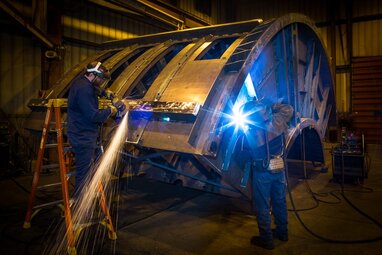
A reputation for design leadership and creating tailored technical advancements sets the company apart from the competition, as does its commitment to providing excellent service.
This 200-person, Crystal Lake, Ilinois-based company doesn’t have time for slowdowns, especially in the welding operation. In recent years though, General Kinematics noticed exactly that. It was experiencing repeated MIG gun breakdowns and excessive contact tip consumption that slowed production.
“Between costs and repairs and lost labor from the welders having issues that stopped their progress, we estimated around $45,000 a year in costs from these issues,” said Jason Jerik, plant manager at General Kinematics.
That’s when Jon Strug, the company’s maintenance tech, approached their welding distributor, Steve Schuette of Weldstar in Aurora, Illinois, for a solution. Schuette recommended a trial of Bernard BTB air-cooled MIG guns with AccuLock™ S consumables.
Considering the change
Problems with the water-cooled MIG welding guns at General Kinematics were at the heart of its need for a new solution.
“The guns were definitely our main issue with maintenance for Jon,” said Joel Jacobson, director of manufacturing. “It was tough to keep up to the demands of the hoses breaking, the wires breaking internally in the guns, tips burning out, liners and such.”
Jerik added, “The last time we calculated from a dollar standpoint it translated to about five to seven hours a week in lost time just with liner issues. It was that frequent.”
The team, along with Schuette, took a slow and thorough approach to testing the Bernard air-cooled BTB MIG welding guns and consumables, making sure that the products performed as expected. They worked first with some sample guns in standard sizes and leads and had different welders try them for a week each.
“We would test a week with one fitter, a week with one welder, and then we’d move them around to see what kind of acceptance we would get with them,” said Jacobson.
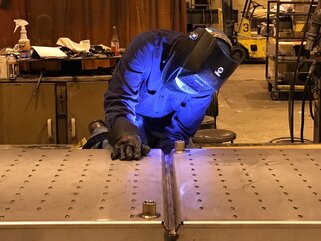
General Kinematics welds a variety of materials — from A-36 steel to AR-500 plate — in thickness up to eight inches and on a variety of joints. Welding operators also weld both large and small weldments and use different welding wire diameters. The guns and consumables needed to be versatile enough to manage these jobs and produce the quality needed to adhere to the American Welding Society (AWS) D.1.1 Structural Welding – Steel code. They also had to be the right equipment for the company’s welding operators.
Jacobson and Jerik regularly met with the welding operators to request feedback during the trial.
According to Jerik, welding operators saw noticeably less consumable consumption. However, they wanted to change the angle on the neck of guns to gain better access to some difficult joint configurations. They worked back and forth with Bernard to determine a different angle of the neck that suited their needs.
“We wanted to do a thorough run of testing and vetting out to decide ‘Is this the right product for us? Are we going to get that buy-in from our welding operators?’” he said.
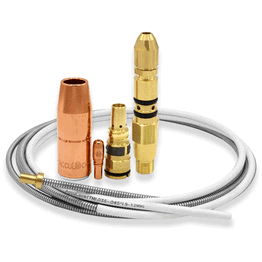
Ensuring that welding operators liked the MIG welding guns and consumables was a critical part of the testing General Kinematics conducted. The company has a culture of empowerment and wanted its welding operators to be heard and to contribute their opinions.
“We think it’s important to get our welders involved early in the process,” said Jacobson. “Not everyone likes change, but getting them involved in testing up front can help show the long-term benefits.”
“I’m huge on that,” Jerik added. “I’d rather not force and push a change onto a team. I’d
rather them accept it and make it their own.”
After eight months of testing, processing feedback and making adjustments, General Kinematics made the decision to convert to the Bernard BTB air-cooled MIG guns and AccuLock S consumables.
The benefit of the investment
General Kinematics invested in 400-amp BTB air-cooled MIG guns for its 40 welding operators, as well as several 450-amp Bernard water-cooled guns — all with the same AccuLock S consumables. Bernard built the company a special neck for its water-cooled guns to provide better ergonomic access to typical weld joints, and these guns are the first of their kind ever to be configured with the AccuLock S consumables.
So, what finally sold General Kinematics on the Bernard products? In short, durability and performance.
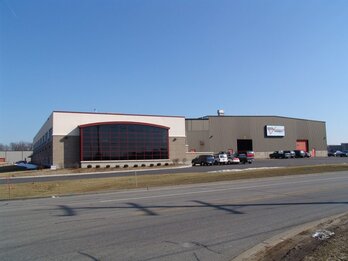
The reduction in gun maintenance was key. Strug no longer has to contend with leaking water-cooled guns or liner issues that need fixing — and the new guns and consumables are less frustrating for the welding operators, who can now spend more time being productive.
“We have a whole lot fewer repairs. Before it was constantly, every month, seven guns I had to send out to get repaired or I had to repair them myself,” said Strug. “It’s a huge difference in quality — night and day.”
This durability and performance result from a combination of the rugged construction of the BTB air-cooled MIG guns — which were configured according to the handle, neck, trigger and cables the company needed — and the liner that is part of the AccuLock S consumables system.
Bernard designed the liner in the system for error-proof replacement by eliminating the need to measure it prior to installation. Instead of the liner loading from the back, like many competitive guns, the AccuLock S liner loads in the neck at the front of the gun and then locks in place so it can be trimmed flush with the power pin. This prevents the liner from being trimmed too short or too long.
“I like the liners,” said Strug. “They last a lot longer and I definitely like the quality of them.”
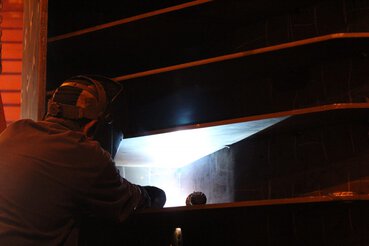
According to Jacobson, another selling point was that AccuLock contact tips run significantly cooler than the company’s previous ones so there is less consumption and downtime for changeover.
That’s due to the design of the tip and gas diffuser. Sixty percent of the welding contact tip is buried in the gas diffuser, which protects it from heat damage, and the shielding gas also cools the contact tip tail as it flows through the gun. AccuLock consumables have a tapered design that locks the tip, gas diffuser and nozzle tightly together to further reduce electrical resistance and lower heat buildup.
Jacobson likes the ability to reduce costs by having equipment that lasts longer. And both the air- and water-cooled MIG welding guns use the same AccuLock S consumables, which helps reduce inventory management.
The welding operators like that the guns and consumables run cooler and help reduce spatter, so there is less cleanup.
The long-term benefits
For General Kinematics, making the change to the Bernard BTB guns and AccuLock S consumables is just another way the company commits itself to quality. But there has been more to the conversion than that.
General Kinematics was able to gain a return on investment in approximately 12 to 14 months. And while there are still labor and equipment costs for gun and consumable maintenance, the conversion has eliminated the $45,000 in extra spending to address previous issues with the water-cooled guns.
The products have also helped its welding operators achieve approximately 10% more productivity by eliminating downtime. That’s important to the welding operators and to Jerik.
“When it comes down to it, do these products make their job easier? Do they make them more productive?”
The answer to both is yes.
How to Prevent 5 Common Welding Gun Failures
How to Prevent 5 Common Welding Gun Failures
Having the right equipment in the welding operation is important — and making sure it works when it’s needed is even more so.
Welding gun failures cause lost time and money, not to mention frustration. Like with many other aspects of the welding operation, the most important way to prevent this problem is education. Understanding how to properly choose, set up and use a MIG gun can help optimize results and eliminate many of the problems that lead to gun failure.
Learn about five common reasons MIG guns fail and how to prevent them.
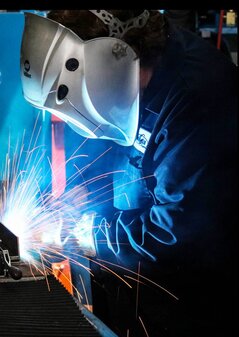
Reason No. 1: Exceeding the gun rating
The rating on a MIG gun reflects the temperatures above which the handle or cable becomes uncomfortably warm. These ratings do not identify the point at which the welding gun risks damage or failure.
Much of the difference lies in the duty cycle of the gun. Because manufacturers can rate their guns at 100%, 60% or 35% duty cycles, there can be significant variances when comparing manufacturer’s products.
Duty cycle is the amount of arc-on time within a 10-minute period. One manufacturer may produce a 400-amp GMAW gun that is capable of welding at 100% duty cycle, while another manufactures the same amperage gun that can weld at only 60% duty cycle. The first gun would be able to weld comfortably at full amperage for a 10-minute time frame, whereas the latter would only be able to weld comfortably for 6 minutes before experiencing higher handle temperatures.
Choose a gun with an amperage rating that matches the necessary duty cycle required and the length of time that the operator will be welding. It’s also important to consider the materials and filler metal wire that will be used. The gun should be able to carry enough power to melt the filler metal wire cleanly and consistently.
Reason No. 2: Improper setup and grounding
Improper system setup can increase the risk of welding gun failure. It’s important to pay attention to not only all consumable connections within the gun, but also all connections in the entire weld circuit to optimize performance.
Proper grounding helps ensure the operator isn’t sending too much power to a restricted window for the power to travel through. Loose or improper ground connections can increase resistance in the electrical circuit.
Be sure to put the ground as close to the workpiece as possible — ideally on the table that holds the workpiece. This helps provide the cleanest circuit structure for the power to travel where it needs to go.
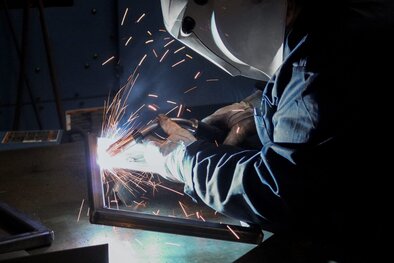
It’s also important to place the ground on clean surfaces so there is metal-to-metal contact; do not use a painted or dirty surface. A clean surface gives the power an easy path to travel rather than create obstructions that create resistance — which increases heat.
Reason No. 3: Loose connections
Consumable connections play an important role in gun performance. Consumables should be tightly secured to the gun, and all threaded connections should also be secure. It’s especially important to check and tighten all connections after a gun has been serviced or repaired.
A loose contact tip or gun neck is an invitation for gun failure at that spot. When connections aren’t tight, heat and resistance can build up. Also, be sure any trigger connect being used is working properly and provides constant power.
Reason No. 4: Damaged power cable
Cables can be easily damaged in the shop or manufacturing environment; for example, by heavy equipment or improper storage. Any damage to the power cable should be repaired as quickly as possible.
Inspect the cable for any cuts or damage; no copper should be exposed in any part of the cable. An exposed line of power in the weld system will try to jump the arc if it touches anything metallic outside of the system. This can result in a wider system failure and a possible safety concern.
Re-terminate the gun and make the cable shorter if necessary, removing any cable sections that have nicks or cuts.
Also be sure the power cable is the proper size for the power that the feeder is supplying to the weld gun. An oversized power cable adds unnecessary weight, while an undersized cable causes heat buildup.
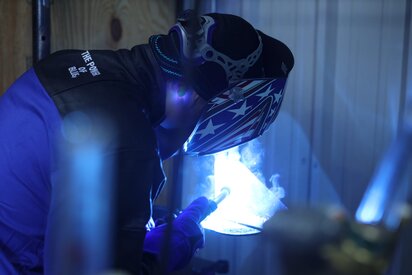
Reason No. 5: Environmental hazards
The manufacturing environment can be harsh for tools and equipment. Take care of tools and equipment to help extend their useful life. Skipping maintenance or treating tools poorly can result in failure and reduced life.
If the welding gun is connected to a boom arm above the weld cell, make sure there are no areas where the gun or cable can be pinched or damaged. Set up the cell so there is a clear path for the cable, to avoid crushing the cable or disrupting shielding gas flow.
Using gun anchors helps keep the gun in a good position and the cable straight — to avoid excessive strain on the cable — when the gun isn’t being used.
Additional thoughts on MIG gun failures
Gun failures in water-cooled welding guns typically happen more frequently than failures in air-cooled gun models. This is primarily due to improper setup.
A water-cooled welding gun requires coolant to chill the system. The coolant must be running before the gun is started because the heat builds quickly. Failure to have the chiller running when welding starts will burn up the gun — requiring replacement of the entire gun.
Welder knowledge and experience regarding how to choose between these guns and maintain them can help prevent many of the issues that result in failures. Small issues can snowball into larger issues within the system, so it’s important to find and address problems with the welding gun when they start to avoid bigger troubles later.
Maintenance Tips
Following some basics tips for preventive maintenance can help extend the life of the welding gun and keep it operating smoothly. It also helps reduce the chances of reactive emergency maintenance that can take the weld cell out of commission.
Regularly inspecting the MIG gun can be an important part of reducing costs and gaining good welding performance. Preventive maintenance doesn’t have to be time-consuming or difficult.
Check the feeder connection regularly. Loose or dirty wire feeder connections cause heat to build up and result in voltage drops. Tighten connections as needed and replace damaged O-rings as necessary.
Properly care for the gun liner. Gun liners can often become clogged with debris during welding. Use compressed air to clear any blockages when wire is changed. Follow manufacturer’s recommendations for trimming and installing the liner.
Inspect the handle and trigger. These components typically require little maintenance beyond visual inspection. Look for cracks in the handle or missing screws, and be sure the gun trigger isn’t sticking or malfunctioning.
Check the gun neck. Loose connections at either end of the neck can cause electrical resistance that results in poor weld quality or consumable failures. Ensure all connections are tight; visually inspect the insulators on the neck and replace if damaged.
Inspect the power cable. Regularly checking the power cable is important to reduce unnecessary equipment costs. Look for any cuts or kinks in the cable and replace as necessary.
Republished from Welding Journal (August 2020) with permission from the American Welding Society (AWS). Click here to view the original article.
From Semi-Automatic to Automatic: Tips for Selecting a Welding Gun
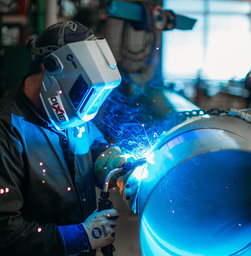
From Semi-Automatic to Automatic: Tips for Selecting a Welding Gun
Choosing the right equipment for a welding operation is critical to achieving high weld quality and productivity while also eliminating costly downtime. And that includes welding guns.
In many cases, companies may have a mix of welding processes and guns. For example, in heavy equipment and general manufacturing, it’s common to have semi-automatic welding along with robotic welding. In oil and gas and shipbuilding applications, semi-automatic welding and fixed automation are prevalent. The combination of welding processes and equipment allows companies serving these industries to weld a variety of part volumes and sizes.
These process mixes, however, can pose challenges in terms of gun selection. That’s why it’s important to know the best welding gun features to look for to achieve the desired weld results — and the best efficiencies.
This article has been published as a web-exclusive on thefabricator.com. To read the entire story, please click here.
The Importance of Cutting a Welding Liner Properly
The Importance of Cutting a Welding Gun Liner Properly
Cutting a welding gun liner correctly is, first and foremost, a matter of proper training. For traditional systems, it’s critical that welding operators understand how to measure and cut the liner to the required length for the gun.
A MIG gun liner that has been cut either too short or too long can lead to a host of issues, most often poor wire feeding. That, in turn, can lead to weld quality issues and rework — both factors that contribute to unnecessary and costly downtime.
The Bernard® AccuLock™ S Consumable System can help eliminate installation issues. First, however, it’s important to understand the pitfalls of standard liner installation to understand the value of this solution.
The problem with welding gun liners
The position of the gun and power cable factors significantly into whether liner installation is successful. If the gun and power cable are twisted or coiled before the welding operator trims the liner, the liner can end up either too long or too short, due to how the cable is constructed.
The copper inside the power cable is wound around a central conduit in a helix or spiral. If the cable is twisted or coiled, it will grow or shrink based on how the copper helix is also twisted. Think of a spring — if it is twisted one way, it grows; if twisted the other way, it shrinks.
For this reason, it’s important to lay the MIG gun and cable straight to avoid any kinks that would lead to an incorrect reading when trimming the liner. Generally, longer power cables are more prone to twisting, so welding operators must take even more care when installing liners in them.
Welding operators may experience the following due to an improperly trimmed liner:
- Poor wire feeding
- Erratic arc
- Birdnesting
- Burnbacks
- Wire chatter
A new solution for welding gun liners
The Bernard® AccuLock™ System eliminates the need to measure when cutting the welding gun liner for replacement. The liner is locked into place by the power pin cap. It is then trimmed flush with the power pin at the back of the gun and power cable. It is still important to lay the gun and cable flat, avoiding twists.
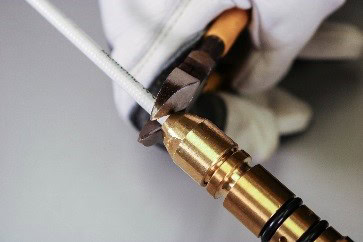
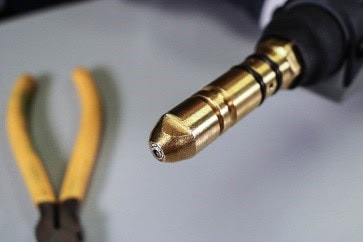
The welding operator can conduct a visual check to determine the liner is in the proper place. This check isn’t possible with a traditional liner if it has been cut too short; the welding operator simply can’t see it under the nozzle and gas diffuser.
The AccuLock System reduces wire feeding issues through the gun, as well, since the liner is locked and concentrically aligned at both the power pin cap and contact tip. This dual lock helps ensure the liner won’t extend or contract as the welding operator changes positions and the power cable naturally bends. The result is the elimination of gaps or misalignments at the front and back of the gun for a flawless wire-feeding path.
As an added benefit, the concentric alignment of the liner reduces mechanical wear on the contact tip that could lead to burnbacks or keyholing, both of which shorten the contact tip life.
For more information please visit the AccuLock S consumables product page.
Tips for Improving MIG Welding
Tips for Improving MIG Welding
Maintaining quality, productivity and cost savings is important in any semi-automatic MIG welding operation, but the steps companies take to achieve those goals vary. Still, there is one constant: the value of skilled welders. They are at the heart of the operation and help ensure its success.
Having the right equipment and understanding how to care for it are also important, as is
revisiting the welding process regularly to ensure its efficiency. Companies should take care to watch for common pitfalls that could negatively affect their progress toward streamlining and improving their operation.
Consider these tips to help along the way:
Welder training
With the industry facing an anticipated welder shortage of 400,000 by 2024, providing training to new welders is critical to supporting a productive and profitable MIG welding operation. In many cases, employees being hired are entirely new to welding or only have limited experience. Learning best practices early on is necessary to achieve the best performance and avoid excessive downtime for troubleshooting.
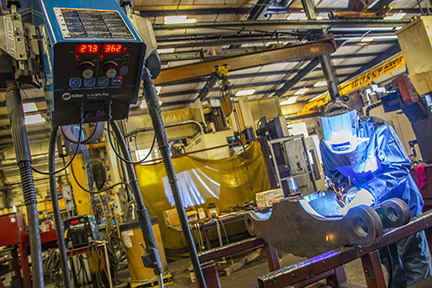
Gaining good weld quality depends on welders knowing proper techniques like gun angle and gun travel speeds and the impact of welding parameters on the process. Even if a company sets lockouts that keep welding parameters within a specific range, it’s valuable for welders to understand the impact voltage, amperage, wire feed speed and shielding gas have on the application.
It’s also important to provide training on other best practices in the MIG welding operation, such as:
- Consulting a checklist for maintenance or equipment checks at the beginning and end of each shift. This can include items like securing weld grounding and checking for gun or cable damage.
- Understanding proper ergonomics to prevent repetitive stress injuries. Having welder input on gun handle types can help with this, too.
- How to correctly install consumables and at what frequency, along with how to identify the signs of contact tip wear.
- Keeping the gun uncoiled and untwisted while using it to help avoid liner movement, which typically leads to wire feeding problems.
- As part of training, encourage welders to be open to asking questions and offer refresher courses to keep skills in top shape.
Assessing the process
To support the long-term efficiency of a MIG welding operation, it’s a good idea to regularly assess each aspect of it.
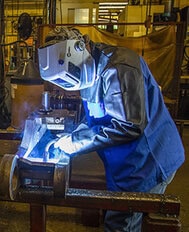
Time studies, for example, offer excellent insight into the entire workflow and allow companies to record the amount of time each task takes to complete. These studies include a breakdown and analysis of parts handling, welding and more. By recording every activity in the operation, it is possible to see whether each one is adding value. If not, adjustments and re-sequencing can be made.
Analyzing the operation can also help identify the need for more welder training. For instance, if a significant amount of time is spent grinding after welding, it can indicate that there are issues contributing to overwelding or poor weld quality. The company can then take proactive steps for additional welder training to improve quality and reduce or eliminate the need for grinding and rework.
Similarly, if welders are spending more time transferring parts than they are welding or there are bottlenecks of parts entering the welding cell, that indicates the workflow needs to be adjusted. The goal is to minimize the amount of time welders spend handling or double handling parts and helps avoid parts from backing up or having welders sit idle waiting for them.
Improving the organization of the workstation as part of a general assessment can also help improve welding productivity. This could include adjusting welding tables and part racks to be more ergonomic so welders are more comfortable and can weld longer.
Welding gun selection and use
Having the correct MIG welding gun for the application can help enhance performance in a MIG welding operation.
One of the first things to consider is cost. Quality MIG welding guns carry a higher price, but they are worth it in the long term. A better gun (when used properly) lasts longer and can help improve weld quality and efficiency over time. Guns that feature mechanical compression fittings, as opposed to crimped fittings, are a good choice. They typically last longer from wear and tear and can also be repaired if damaged, which saves money on replacement guns.
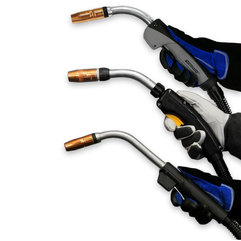
Be certain to choose a gun with the appropriate amperage rating and duty cycle for the application to prevent overheating. A lower amperage MIG welding gun may be appealing to a welder due to its lighter weight and flexibility; however, it will not be able to withstand an application requiring higher amperages and long arc-on times.
Effectively grounding the weld circuit is another way to gain weld quality and productivity in a semi-automatic welding operation. It can also protect the welding gun from overheating and from wearing out consumables too quickly. Installing the ground clamp as close to the weld as possible and limiting the amount of connections can help to prevent one or more from coming loose over time or creating electrical resistance.
Always choose correctly sized ground cables for the weld circuit and the right type of ground clamp. A C-clamp is a good option as it is a tighter connection versus a spring clamp, which helps prevent arcing at the ground that could lead to an erratic arc. As with other quality components in a MIG welding operation, C-clamps can be more expensive, but they offer a connection that can better protect the gun and save on replacement or repair costs.
Lastly, take care to inspect the welding gun cable regularly for damage and replace as necessary. Nicks or cuts in the cable can expose bare copper, causing a safety hazard of electrical shock, as well as erratic welding issues. Adding a cable jacket cover is a proactive step in avoiding these problems.
The role of consumables and wire
Contact tips, nozzles, gas diffusers and liners all affect MIG welding performance. Ideally, select consumables and wire designed to complement one another as a system. These can help maintain solid connections that provide the best electrical conductivity and arc stability.
Always trim the liner properly — per the guns owner’s manual — to avoid erratic arcs and burn backs or look for liners that lock into place and require no measurement to avoid trimming them too long or too short.
For semi-automatic MIG welding, copper contact tips work well; however, if more tip life is desired or needed, chrome zirconium tips are an alternative to better resist physical tip wear (also known as keyholing). It helps to monitor how often contact tips are being changed to avoid straying too far from the originally planned frequency of tip changeover. If tip changes begin to increase drastically, then this points to incorrect installation of consumables, a liner being cut too short or other damage in the system. Monitoring consumables usage can also help identify when contact tips could still have life left in them. If contact tips are changed too early, this results in unnecessary downtime.
Also consider the wire being used. Quality is key here, too. Less expensive wires often have an irregular cast or helix or an inconsistent layer of lubricant. All of these factors can lead to weld quality issues and additional wear on the contact tips.
Keeping on track
Maintaining an efficient MIG welding operation takes time and resources, but it’s worthwhile to make an investment in welders and equipment to achieve the best results. Continue to monitor the process for improvement opportunities and engage welders whenever possible. Since welders are responsible for moving quality and productivity forward, their ideas can be a valuable asset.
Selecting Contact Tips for Robotic Welding
Selecting Contact Tips for Robotic Welding
Contact tips are often referred to as the smallest fuse in the fuse box that is your robotic welding cell. But this small fuse can have a big impact on productivity. In terms of overall efficiency, the contact tip is key.
Contact tips depend upon repeatability to be effective in the welding process. Learn more about the different types of available — and how choosing the right one for your application can improve results and save money.
How do contact tips affect efficiency?
The job of the contact tip is to transfer the welding current to the arc and guide the welding wire as consistently as possible. If either of these two factors degrade, the overall welding process also degrades, affecting quality.
When an operation changes contact tips every few hours, there is an obvious effect on productivity. It requires the weld cell to be shut down, and the operator may have to enter the cell to change out the tip. If the robot is buried inside the welding line, contact tip changeover takes even longer.
Not only are these changeovers inefficient, but they also introduce the potential for mistakes. Every time a human interacts with the robot, there’s a risk of incorrect consumable installation or other improper adjustments that can lead to poor quality welds and costly rework.
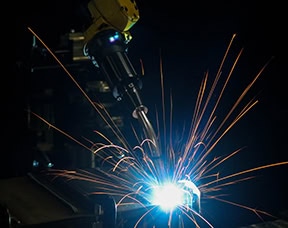
fuse in the fuse box that is your robotic
welding cell. But this small fuse can have
a big impact on productivity.
Choosing the right tip depends on the results you’re looking for and the needs of the application. In the automotive industry, for example, choosing a quality contact tip is critical since unplanned downtime is the enemy of a high-volume multi-robot operation. Contact tips in these applications need more wear resistance.
A high-quality contact tip provides a longer life and a more consistent and stable arc. Longer tip life results in more robot uptime, less time wasted on non-value-added labor for tip changeovers and reduced human interaction with the robot that could lead to error. But the contact tip itself isn’t the only factor impacting tip life — the welding wire, part fit-up, robot programming and grounding also contribute.
Types of contact tips
There are several types of contact tips available. Understanding the differences can help you select the best choice for your operation.
1. Copper contact tips: Contact tips made from this material are the most conductive to transfer welding current. But copper is also the softest option and will keyhole (or wear the bore unevenly) much faster. If keyholing is a pain point in your operation, this may not be the best choice. The initial cost of copper contact tips tends to be cheaper than other options.
2. Chrome-zirconium contact tips: This alloy provides better wear resistance and longer life than copper tips, holding up better to the demands and increased arc-on time of robotic welding. They are slightly less conductive than copper tips, but they are still sufficient for most robotic applications.
3. HDP contact tips: HDP tips can last 10 times longer than copper tips — and up to 30 times in some cases — depending on the application and waveform being used. Operations may be able to go from changing contact tips every two hours to only changing tips once a week. HDP contact tips are engineered to endure wear better, providing increased resistance to arc erosion in pulsed welding, as well as spray transfer and CV MIG. The precise fit between the tip and the wire also results in good arc stability to help produce high-quality welds. Because HDP contact tips reduce the impact of the welding current decline over time, they can provide a more stable and consistent arc over the life of each contact tip. These tips work best in applications that use high-quality copper-coated solid wire.
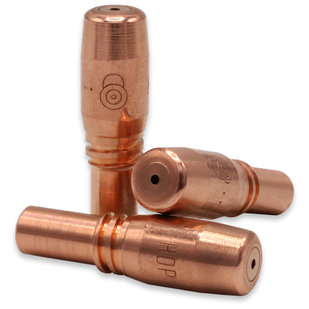
Common pitfalls with contact tips
Once you understand the types of contact tips available, there are numerous factors to consider when choosing the right tip for your application. Here are some common mistakes operations make when choosing contact tips so you can avoid the same pitfalls:
1. Only considering price: Many operations may look only at the price per tip when they purchase contact tips. But it’s important to look beyond the initial price and consider the big picture, which includes the downtime and labor required for changeover, along with any quality issues that may be happening in the weld cell. If a contact tip lasts three times as long, the robot can continue to weld instead of being down for a tip changeover — and there is less human interaction inside the cell .
2. Ignoring ID tolerance issues: The size and cast of the welding wire are important in making a decision about contact tips. Some tips need to be undersized for the welding wire used, while some tips need to match the wire size. And the same exact wire will vary in the necessary contact tip size depending on if the wire comes in a small spool or a 1,000-pound barrel. For most copper and chrome-zirconium tips, it’s recommended to undersize the contact tip by a single wire size when using a 500-pound barrel or greater of wire due to the wire cast. With smaller sizes of wire packaging, use contact tips that match the wire size. The goal is to maintain a clean, consistent contact between the wire and the tip so the weld current is conducted as efficiently as possible.
3. Using poor quality wire: In most cases, poor quality welding wire will lead to poor results from your contact tips. This is due to the lubrication on the wire, as well as the consistency of the wire diameter; inconsistent wire diameter wears the tip faster. Choosing a higher quality wire can improve tip life and produce better results. Also, be aware that wires without a copper coating and cored wires wear tips much faster. Using copper-coated solid wires typically slows contact tip wear.
4. Not being open to change: Some companies think the status quo is fine because they aren’t experiencing issues. They change tips in the robotic welding cell every couple of hours, even if those tips don’t need to be changed. Looking at the true length of their current tips or investing in higher-quality tips could optimize efficiency and the overall process — saving unplanned downtime and reducing the need for non-value-added labor hours.
Analyzing the robotic operation
If contact tips are being removed proactively even when there is no keyholing, burnbacks or erratic arcs, there could be potential to get more life out of contact tips.
So how can companies best analyze their robotic welding operation to determine when to change to a different type of contact tip?
Contact tips react differently to different applications, so an important first step is to run trials with varying quality levels of tips. This will provide an accurate comparison and a level set for expectations. Run each tip to failure, including the current brand, rather than proactively changing the tip on a set schedule. Be sure to log the time each part lasted. Ideally, run multiple contact tips in any trial to eliminate any outliers.
This type of trial can help to identify how much labor time is spent on tip changeovers, how much robot uptime can be achieved and what failures are occurring with each type of contact tip.
If an operation previously experienced 10 burnbacks a day and reduces that to zero by using a higher quality contact tip, this can help eliminate unplanned downtime.
Optimizing contact tip efficiency in robotic welding
It’s important to look beyond the purchase cost and consider the big picture to best evaluate the potential productivity, as well as weld quality and efficiency gains of certain contact tips. The benefits can be especially significant in robotic welding applications, where regular contact tip changeovers can be greatly reduced.
How Robotic Welding Supervisors Can Improve the Operation
How Robotic Welding Supervisors Can Improve the Operation
Gaining a good return on investment (ROI) from a robotic welding system doesn’t happen by chance. It’s a matter of optimizing the robot and the robotic welding cell to operate at peak efficiency. And while this task is a team effort, it is led by the robotic welding supervisor.
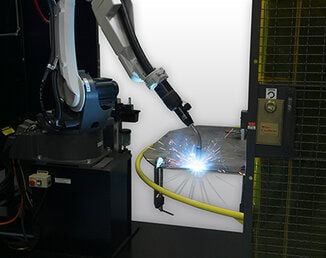
So, what can the supervisor do to guide the way, while looking at more advanced considerations? Pay close attention and collaborate.
Find opportunities for improvement
Even if a robotic welding system is meeting production and quality requirements, it’s important that robotic welding supervisors commit to a continuous improvement process. Regularly looking for ways to increase efficiencies could provide the ability to produce more parts. It can also help identify issues within the robotic welding cell before they become problematic and cause downtime.
Robotic supervisors should pay close attention to details such as cable and consumable management, parts handling and workflow to pinpoint areas that could be streamlined. The goal is to avoid settling for less than optimal work practices to realize the full potential of the system. Doing so can provide companies with higher productivity and profitability and can set them apart from their competitors.
Rely on available resources
While the robotic welding supervisor may oversee the overall health of a robotic welding cell, the robot operator works hands on with the system daily to load and unload parts. For this reason, they are an excellent resource to rely on for insight into potential or existing problems, such as:
• Excessive spatter
• Poor joint configurations, or
• The need for tooling adjustments
Quality technicians are another internal resource to help the robotic welding supervisor identify any issues and drive performance improvements. In conjunction with welding engineers, they can help rectify issues like overwelding or part distortion.
External sources, such as a robotic welding integrator or equipment manufacturer, can help troubleshoot and offer advice to gain efficiencies. In many cases, they can also offer ongoing training that helps everyone improve their interaction with the robotic welding cell.
This article is the second in a two-part series focused on key information welding supervisors should know to help ensure robotic welding success. Read article one, Best Practices for Robotic Welding Supervisors.
Best Practices for Robotic Welding Supervisors
Best Practices for Robotic Welding Supervisors
With careful planning and attention to detail, companies that invest in a robotic welding system can gain advantages, such as:
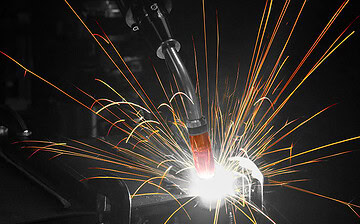
• Increased productivity
• High weld quality
• Cost saving
• Parts consistency
The welding supervisor managing the robotic welding cell plays a key role in achieving these results — and with some best practices in mind, can help ensure long-term success. There are some basics that provide a good starting point.
Understand the robotic welding system
To maximize uptime in a robotic welding system, welding supervisors need to look beyond the administrative and operational duties often involved with this position and consider the actual components in the system. Maintenance personnel can often help.
It’s important for welding supervisors to understand how to quickly troubleshoot issues and how to adjust the weld programs, as needed.
Having a solid understanding of the functions of the robotic welding gun, welding consumables, power cables, and their impact on quality and productivity is also important. It makes it easier to identify problems and provide the best solution.
Establish documentation and maintenance
Keeping an accurate, detailed log of all activities in a robotic welding cell can help welding supervisors maintain control over changes that could impact performance of the robotic welding system. Information to document includes:
• The names of all employees who enter the weld cell, when they entered and why
• Parts that have been cleaned
• Consumable changes
• Drive roll tension adjustments
• Installation of a new welding wire drum
This documentation provides insight into changes in the robotic weld cell, making it easier for maintenance staff to troubleshoot any issues. It can also help the welding supervisor and maintenance personnel determine the appropriate frequency for a preventive maintenance schedule, which helps reduce unexpected downtime.
This article is the first in a two-part series focused on key information welding supervisors should know to help ensure robotic welding success. Read article two, How Robotic Welding Supervisors Can Improve the Operation.
Understanding Fixed Automatic Welding Guns
Understanding Fixed Automatic Welding Guns
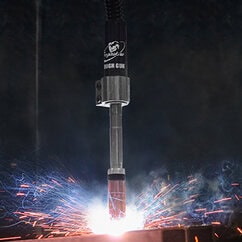
When it comes to automating the welding process, many companies opt for robotic welding systems due to the flexibility they provide and their ability to reach and weld multiple joints. These systems provide the advantages of speed and accuracy and can be reprogrammed to manage new projects.
But these robotic systems aren’t right for every application. In industries such as oil and gas, railcar, structural steel fabrication and shipbuilding, joint configurations are often less complex, consisting of a single part to be welded as opposed to full assemblies. In this case, fixed automatic welding is generally preferred.
About fixed automation welding
Fixed automation welding, sometimes called hard automation welding, is commonly used for welding pipes, structural beams, tanks and vessels in a shop environment prior to them being moved to the jobsite where they will be placed into service. It can also be used for welding steel plates for the general fabrication industry or in the manufacturing of hot water heaters and propane tanks.
Common Factors for Suitable Applications
One common factor in these applications is the need for either longitudinal or circular (inside or outside diameter) welds that require repeatability as opposed to versatility. Other factors that make applications suitable for fixed automation welding include:
1. A high volume of similar parts with low variety
2. Large parts with very long welds or several similar welds
3. Large parts that would be difficult to weld manually
In some cases, fixed automation welding can help companies meet high production goals at relatively low cost. And it is easy for a single operator to oversee and load parts, making it desirable from a labor perspective — particularly given the shortage of skilled welders the industry is facing.
Setups
A fixed automation welding cell can be set up in two ways. The first option requires tooling that holds the part in place, while a fixed automatic gun moves along the weld joint by way of a mechanized seam welder or a track and carriage that holds the gun in place. This option would be viable for a long structural beam, for example.
In the second scenario, the welding gun may be fixed in a single place by tooling while the part, such as a pipe, rotates on a lathe or circumferential fixture during the welding process. In today’s marketplace, there is equipment that can rotate parts in a wide range of diameters and weights.
Tooling for fixed automation welding offers minimal flexibility and can be expensive to adjust for new parts. This is true particularly in comparison to a robotic welding system that can be reprogrammed to articulate and weld in different positions along the X, Y and Z axes.
When investing in the tooling for fixed automation welding, it’s important for companies to determine upfront what their long-term applications will be. Will they continue to weld parts that are straight or circular for the foreseeable future?
Avoiding pitfalls in the process
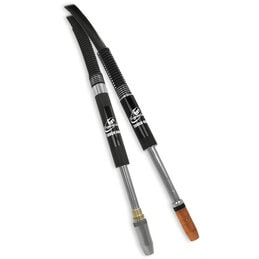
One very important part of the fixed automation welding system is the welding gun. It is not uncommon for companies to take a do-it-yourself (DIY) approach to this piece of equipment. Namely fixturing a semi-automatic gun in place with various components to mimic the performance of a fixed automatic gun. Sometimes this is done out of convenience, due to the shop having an abundance of semi-automatic guns, or because of a perceived cost savings.
Unfortunately, a DIY gun assembly for this process can be time-consuming to set up and maintain, which adversely affects productivity. It also is not optimized for fixed automation welding. Quality may suffer due to off-seam welds or other inconsistencies, leading to rework that further reduces throughput and increases costs. Also, if replacement parts are needed there could be variations in the assembly since it is not set up for this process. Again, this can lead to quality issues.
Instead, it is important to invest in a fixed automatic gun that is designed for the process. These guns have consistent components that can be sourced from manufacturers so that the welds are repeatable. And the gun manufacturers can provide service and technical support.
Looking at the choices
Guns need to be specified or customized for the application according to the available space, taking into account the distance between the gun and the part and also how far away the wire feeder is. These factors impact neck length and bend or angle, as well as cable choices.
Necks
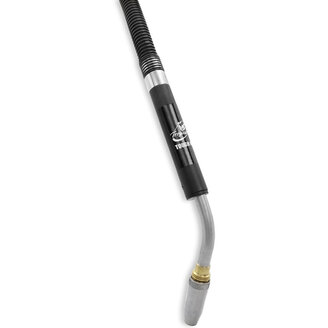
Necks are typically available in the marketplace in varying lengths, from approximately 4 to 12 inches. Available with either a straight neck or 22-, 45- and 60-degree bends. Companies need to determine the reach required to meet the weld joint, as well as the necessary angle for completing a sound weld.
Cable Lengths
Cable lengths vary from as short as 3 feet to as long as 25 feet. Longer cables are ideal for reaching a wire feeder placed further away from the part, including on a boom. In other situations, a company may mount the feeder directly on the tooling or nearby. In that case, a cableless gun is an option for air-cooled operations. These guns plug directly into the wire feeder via a power pin and do not require a cable. Amperage and duty cycle also need to be factored into the selection of a fixed automatic gun, and both depend on the thickness of the material being welded and the amount of arc-on time required.
Air-cooled fixed automatic guns are typically available from 300 to 500 amperage models, offering either 60% or 100% duty cycle. Duty cycle is defined by the amount of time within a 10-minute cycle the gun can weld without becoming overly heated.
The necks on these guns are particularly durable since they have fewer internal channels than a water-cooled gun and rely on the ambient air to cool them. They are also more resistant to bending, and replacement parts are less expensive.
For higher-amperage fixed automation welding applications that require longer periods of welding on thicker material, a water-cooled gun may be a better choice. These models are typically available in amperages ranging from 450 to 600 amps and offering 100% duty cycle.
Hybrid water-cooled guns are another option. These fixed automatic guns have a sturdy neck similar to an air-cooled model with water channels running external to it. These channels make the guns easier to maintain than water-cooled guns.
Additional considerations
Along with selecting the appropriate components for a fixed automatic gun, it’s also essential to choose high-quality consumables — nozzles, contact tips and gas diffusers. This helps minimize downtime for frequent changeovers and supports production goals. They can also reduce quality issues that could require rework later in the welding operation.
Consumables are available that can be used across different types of welding guns, including semi-automatic ones and fixed automatic guns. This compatibility can be beneficial to simplifying inventory and preventing errors when installing new consumables on either type of gun.
